

Victory for last operational Second World War motor boats
The last remaining fully operational high-speed World War II motor boats have been saved for the nation today with the help of a £580,000 grant from the National Heritage Memorial Fund (NHMF).
When built, they were the fastest boats of their type in the world. One of the boats, MGB 81, was active during the US landing at Omaha Beach during D-Day and received the battle honour ‘Normandy 1944’. The other, HSL 102, is the only surviving example of the 100 class high speed launch and was stationed at RAF Calshot during the Battle of Britain, retrieving shot down airmen from the sea. Throughout the duration of the war, HSL vessels saved a total of 10,000 airmen of many nationalities.
The money will enable Portsmouth Naval Base Property Trust (PNBPT) to purchase the gunboats. Although both were outstanding examples of British naval engineering, they only had a life expectancy of 20 years. They have now been restored to original working condition and will go on permanent display at Gunwharf Quays Marina in Portsmouth. It is hoped people will get the opportunity to charter the boats and experience what it was like for the crews driving at full speed 70 years ago.
Lt. James Shadbolt MBE and a veteran of Royal Navy's 8th Motor Gunboat Flotilla, said: “I’m delighted these two motorboats will now be safe-guarded. Organisations like NHMF and other generous donors play such a vital role in protecting our precious heritage and those of us who particularly cherish these boats are very grateful. It’s wonderful to know that future generations will be able to experience first-hand these extremely exciting machines just as we did as young men during the war."
Bob Bewley, Director of Operations at NHMF, said: “The purchase of these boats is an important part of a continuing success story and just what the NHMF was set up to do - to defend the most outstanding parts of our national heritage at risk as a memorial to those who have died for the UK. These gunboats are so integral to our rich seafaring history. They can now join other great British naval achievements, such as Nelson’s HMS Victory and the Mary Rose, which have been saved thanks to the unique ability of the NHMF to act quickly as the ‘fund of last resort’ over the past 30 years.”
Peter Goodship, Chief Executive of the PNBPT, said: “These unique craft are a legacy to the heroism of those who crewed them during World War II. Both boats made significant contributions to the War effort and saved the lives of many sailors and airmen. The Trust is grateful to all those who contributed, especially the National Heritage Memorial Fund, without which this would not have been possible.”
History of the Boats
The boats were designed and built by the British Powerboat Company, which later went on to build the famous Supermarine Spitfire. The company’s founder, aviation and powerboat pioneer Hubert Scott-Paine, along with T.E. Shaw (known as Lawrence of Arabia), pioneered these fast manoeuvrable craft for British military use. In fact, T.E. Shaw personally undertook the testing of the HSL prototype.
MGB 81 - After the war, MGB 81 was disposed of by the Royal Navy. In late 1945, she was sold to a private owner, achieving notoriety for being ‘arrested’ as part of a smuggling operation in 1958 and then was sold for scrap. Later, she became an accommodation barge for a sailing school and then spent some years as a house boat before restoration in 1988.
HSL 102 - During a two month period HSL 102 is recorded as having saved 38 men from the North Sea including the crews of two German bombers. After restoration in 1996, she was re-launched by HM Queen Elizabeth, the Queen Mother, and performed as a Royal Barge for both HRH Prince Phillip and HRH the Duke of Kent. She went on to star in the film Enigma with Kate Winslet in 2001.
Notes to editors
The acquisition cost £750,000 which was made up of five funding streams: National Heritage Memorial Fund - £580,000 (77 per cent of the total value) Private donations - £90,000 Fundraising - £50,000 PRISM - £20,000 Coastal Forces Trust - £10,000
Portsmouth Naval Base Property Trust
PNBPT was set up in 1985 by the Ministry of Defence and Portsmouth City Council with the initial purpose of taking responsibility for the long-term preservation of the historic south-west corner of Portsmouth Naval Base.
The Trust now owns and manages several of the attractions within the Historic Dockyard and Portsmouth Harbour, including Action Stations, Explosion Museum of Naval Firepower, Harbour Tours and the Dockyard Apprentice Exhibition. Since its foundation, it has also established one of the UK’s largest collections of small naval craft, many of which are on display within the Historic Dockyard. These include the former barge of Commander-in-Chief Naval Home Command, a harbour defence launch, gigs, whalers, cutters, small dinghies used for Royal Naval sailing training, and a World War II landing craft. The Trust recently inherited the former British Military Powerboat Trust’s collection, which includes a small Air Sea Rescue craft and a motorboat tender from Ark Royal.
HLS 102 and MGB 81 will represent the Trust’s most significant acquisitions to date.
Further information
Natasha Ley or Alison Scott, NHMF Press Officers, Phone: (020) 7591 6143 / 6032 Mobile: 07973 613 820 Email: [email protected] / [email protected] .
- About the NHMF
- Marina Services
- Berthon Lymington Marina Rates
- Meet The Dockmasters
- Tide Times & Weather
- Fuelling at Berthon
- Lymington FAQ
- Lymington Marina Terms of Business
- Boatyard Rates
- Refits and Repairs
- Paint Facility
- Dry Sailing
- Terms of Business
- Commercial Boatbuilding Service
- New Boat Designs
- Commercial RIBs
- Superyacht Tender Support
- Marine Services
- Berthon History
- Berthon Blog
- Client Testimonials
- Careers at Berthon
- Marine Apprenticeships
- How to find us
- Boatyard Services
- Yacht Sales
Home / Berthon Boatyard / Yacht Refit and Refurbishment / WW2 MGB 81 Motor Gun Boat Restoration
WW2 MGB 81 Motor Gun Boat Restoration
Berthon’s history with the Motor Gun Boats (MGB) and Motor Torpedo Boats (MTB) goes all the way back to 1939 when numerous MGB and MTB hulls and complete boats were built or fitted out at our boat yard during World War Two. This adaptable hull design allowed the vessel to be converted between a torpedo and gunboat variant depending on upcoming missions.
As well as this history, Berthon’s experience was a key factor in MGB81 being restored at our shipyard. Berthon’s traditional shipwrighting knowledge in restoring and refitting boats at our state of the art facilities is unrivalled in the UK, coupled with our award-winning apprenticeship scheme ensures these skills are also passed on to the next generation.
Berthon was awarded the contract by Portsmouth Naval Base Property Trust for the restoration and re-engining of the famous Motor Gun Boat 81 (MGB81) funded by the Chancellor using LIBOR funds.
MGB 81 is a 71.5ft Motor Gun Boat built by the British Powerboat Company for the Royal Navy and launched on 26 June 1942. When built, she was among the fastest boat of her type in the world and capable of speeds in excess of 42 knots. MGB 81 and her sister vessels were involved in the action in the English Channel, attacking enemy torpedo boats and landing secret agents on occupied soil. She was later involved in D-Day operations. MGB 81 is unique as she is the only restored and operational example of a Royal Navy Coastal Forces MGB which saw active service in WW2. As a result of the restoration techniques used, she retains most of her original performance capabilities but is stronger, lighter and require less maintenance.
The refit stripped her from stem to stern, and replaced the structural frames and longitudinal stringers in pairs so as to safeguard the original hull and fittings and keep it as original as possible. One of the largest jobs included replacing the 3 MAN 835hp engines with 3 new, Mermaid Marine supplied, FPT C13 825hp diesel engines. Both Berthon and the PNBPT wanted to keep MGB 81 as original as possible. However, the replacement engines are more reliable, fuel efficient and lighter than the originals.
MGB81 VIDEOS
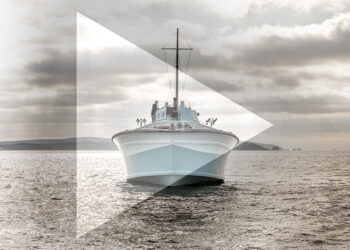
MGB 81 Video Playlist
Watch the full series here
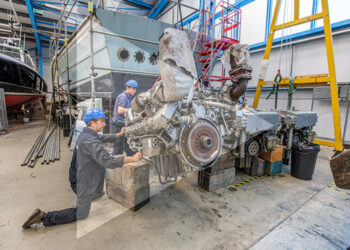
Engine Removal Overview | Part 1 of 15
Part 1 of 14
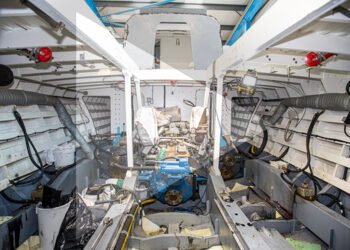
Engine Removal Timelapse
Part 2 of 14
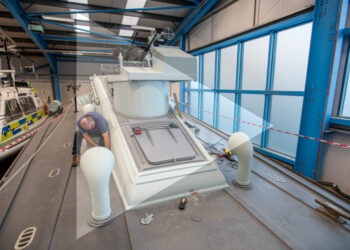
Removing the Engines - Part 1/3 - Aft Superstructure Removal
Part 3 of 14
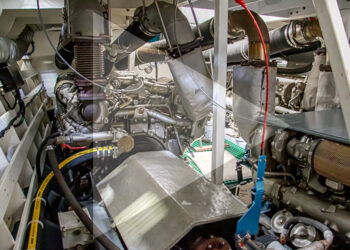
Removing the Engines - Part 2/3 - Stripping Engine Room
Part 4 of 14
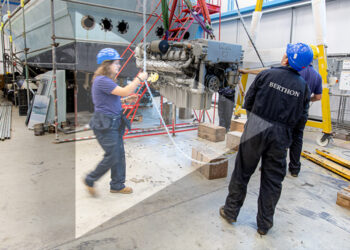
Removing the Engines - Part 3/3 - Engine Removal
Part 5 of 14
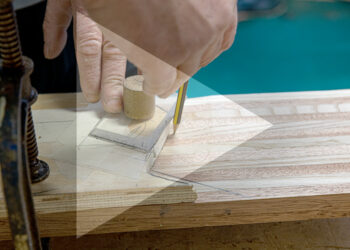
Interior - Part 1/5 - Laminating & Shaping Hull Frames
Part 6 of 14
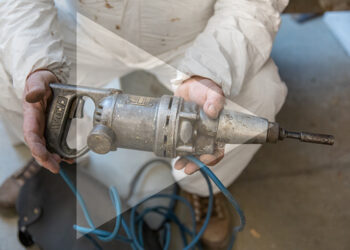
Interior - Part 2/5 - Fitting Hull Frames
Part 7 of 14
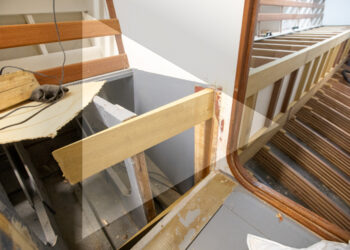
Interior - Part 3/5 - Box Stringers, & Bunk Fronts
Part 8 of 14
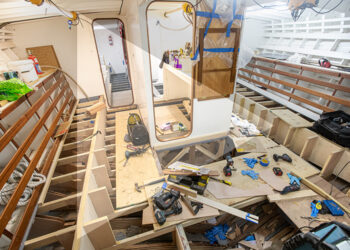
Interior - Part 4/5 - Bunk Structure & Webs
Part 9 of 14
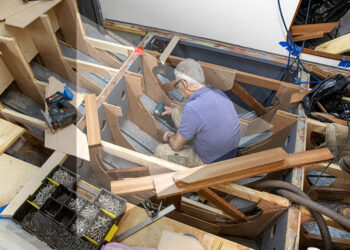
Interior - Part 5/5 - Deck Structure & Flooring
Part 10 of 14
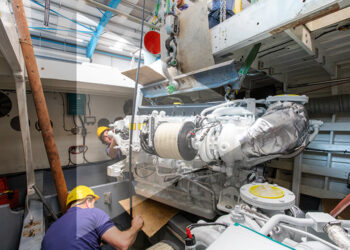
New Engine Installation - Part 1/3 - Fitting New Engines
Part 11 of 14
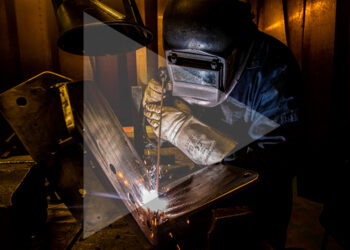
New Engine Installation - Part 2/3 - Fabricating Engine Mounts
Part 12 of 14
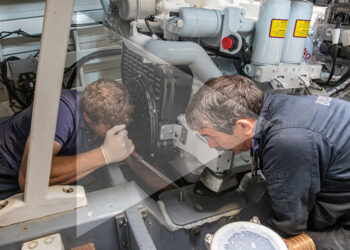
New Engine Installation - Part 3/3 - Fitting Engine Mounts & Feet
Part 13 of 14
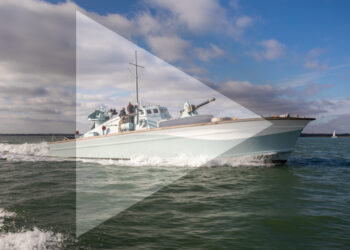
MGB81 Sea Trials
Part 14 of 14
Restoration
Engine removal.
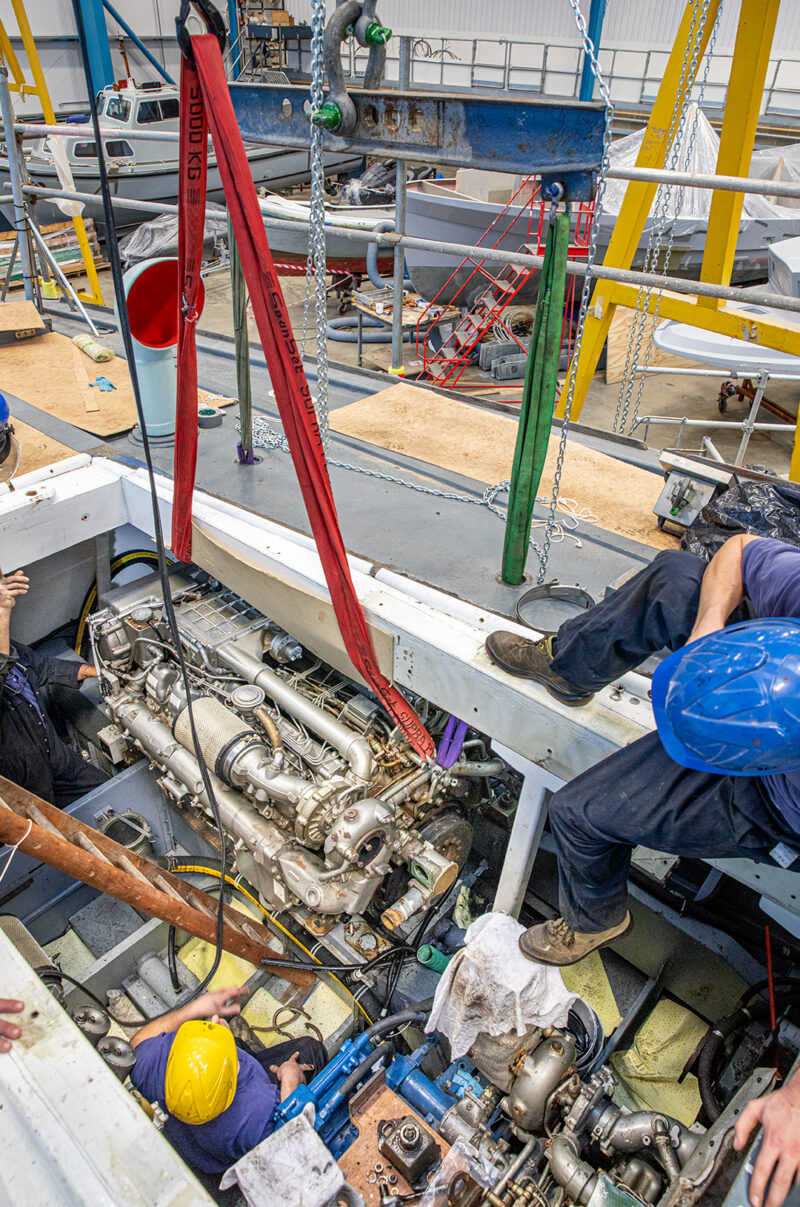
The entire aft superstructure, including replica twin 20 mm Oerlikon cannon and turret had to be removed, revealing a soft patch large enough for the engines to fit through.
With the aft superstructure safely stowed , Berthon engineers dismantled six exhausts and supporting brackets, the aft generator (which had been hidden in the stern from when she was a house boat), drive shafts for the port and starboard engines, prop shafts and props from all three engines, battery banks and the mid ship gear box (as this was mounted directly to the engine without a drive shaft); exhaust fittings and oil filters followed to enable the engines to be drained of all fluids reducing weight and prevent an unsafe lift before stowing them adjacent to the boat..
Two cranes were used to lift each engine out, one to lift the 1,900 kilogram engine high enough so that the sump would clear the engine supports, and the second to swing it into place before being lifted out. This intricate process involves patience and careful coordination as per the diagram below ( or view the video coverage ) And prior to the final lift and drop to shed floor level the first strop was reattached to the engine to act as an additional safety line.
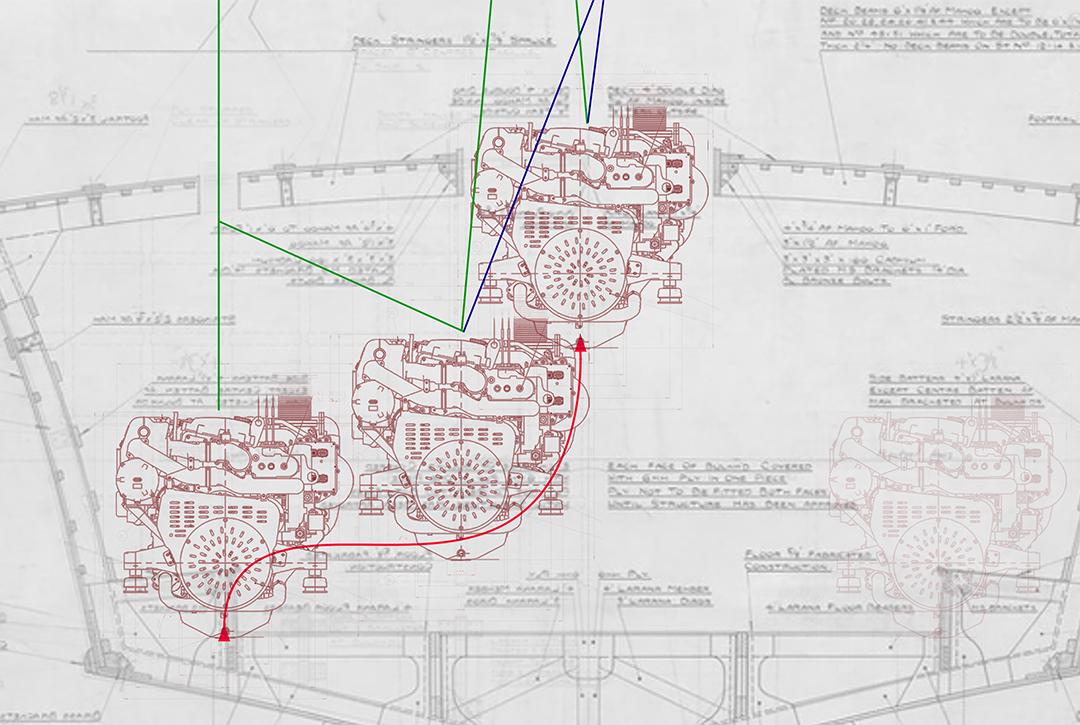
Removal of Interior
Before any of the work could begin all removable panels, ie bunk tops and floor panels, were dismantled and stored; this exposed the delamination of the frames. To gain access to these, the floor bearers and bunk supports had to be removed which included the outer longitudinal which was also the bunk front port and starboard.
Cengar jigsaws were used to remove the affected frames and a reciprocating saw was then used to cut the frames into shorter sections to make removal easier; mauls and lump hammers were the tools of choice to detach remnants. Unfortunately, there is no delicate way to remove these original but sadly partly rotten structures as everything was glued in place along with hundreds of ring nails and screws.
With the frames removed there were still sections of plywood biscuits still attached to the topside frames, so these were carefully chiselled off in order to protect the 76-year-old mahogany diag hull planking. The screws and nails were subsequently cut off and ground flat before the hull was sanded and cleaned for the new frames to be added.
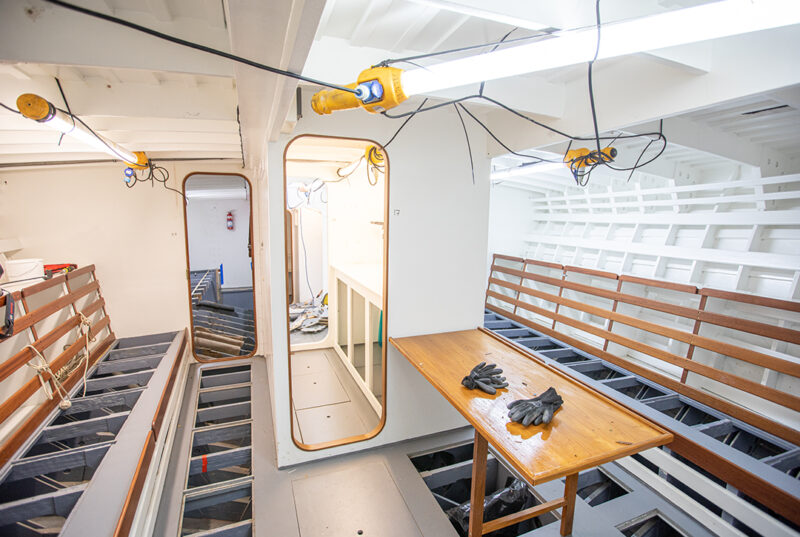
Hull Frames
Each new frame is made up of 12 planks, made from a flexible, light ash and a heavier stronger utile (hardwood), these are glued together to make a strong and flexible frame. Every pair of frames is a different shape, as the curve of the MGB hull becomes more pronounced as it gets closer to the front. This meant that every time a new set of frames is laminated the jig has to be adjusted, even if it is only by a few millimetres. After the main shape has been formed a template is set up along the original beams’ position, and a more accurate shape is taken. This is done with a spiling block.
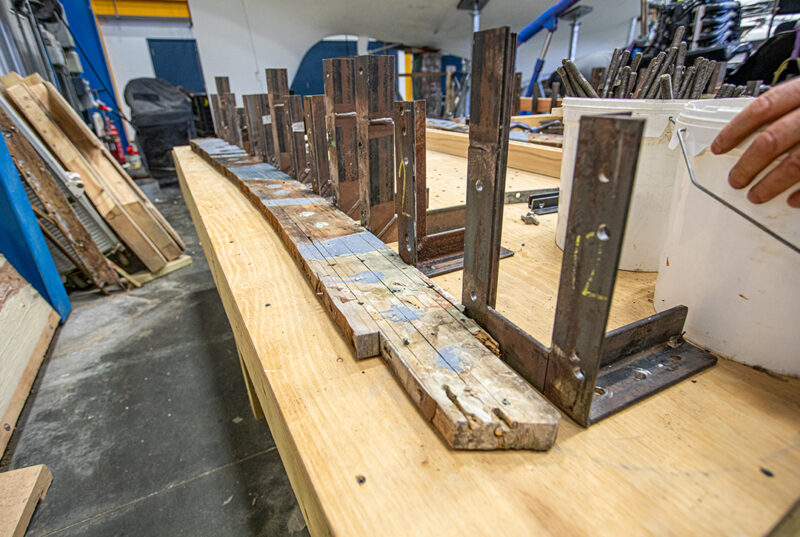
Spiling can be an art form in itself. It is generally used in carpentry and shipbuilding, when the dimension is taken from a straight line, a mould’s edge or rule staff, to any given side or curve of a plank’s edge.
This is then placed in the jig and clamped in place to create the correct curve. Once it has had time to fully dry it is cut into two halves to form 2 individual and identical frames, one port and one starboard. This process is repeated 24 times to create the 48 new frames. This is a perfect teaching opportunity for our apprentices since spiling and making up laminated frames for old wooden craft is not an every-day ask in a modern boatyard.
The template is lifted off and laid out on the new timber to be cut, the marks are then transferred in reverse using the same spiling block. A continuous line using a fairing batten then joins these points.
When it comes to replacing an old plank or panel the most obvious way is to copy it by simply tracing around the old one. However, getting an old plank out without it breaking or distorting is much easier said than done. Especially one that is water damaged and rotten.
The new frame is then cut to shape and fitted into place in the original position. To get the perfect fit, as spiling is accurate but not perfect, the frame is finally planed in position until it is a seamless fit.When the team are happy with the position and fit of the frames, pilot holes are drilled through the hull every 8 inches following the line of the frame.
The beams are then dry fitted in place before being glued, clamped and wedged, with wooden pegs to prevent any slipping.
From the outside and using the previously drilled pilot holes for guides the frames are permanently screwed in place.
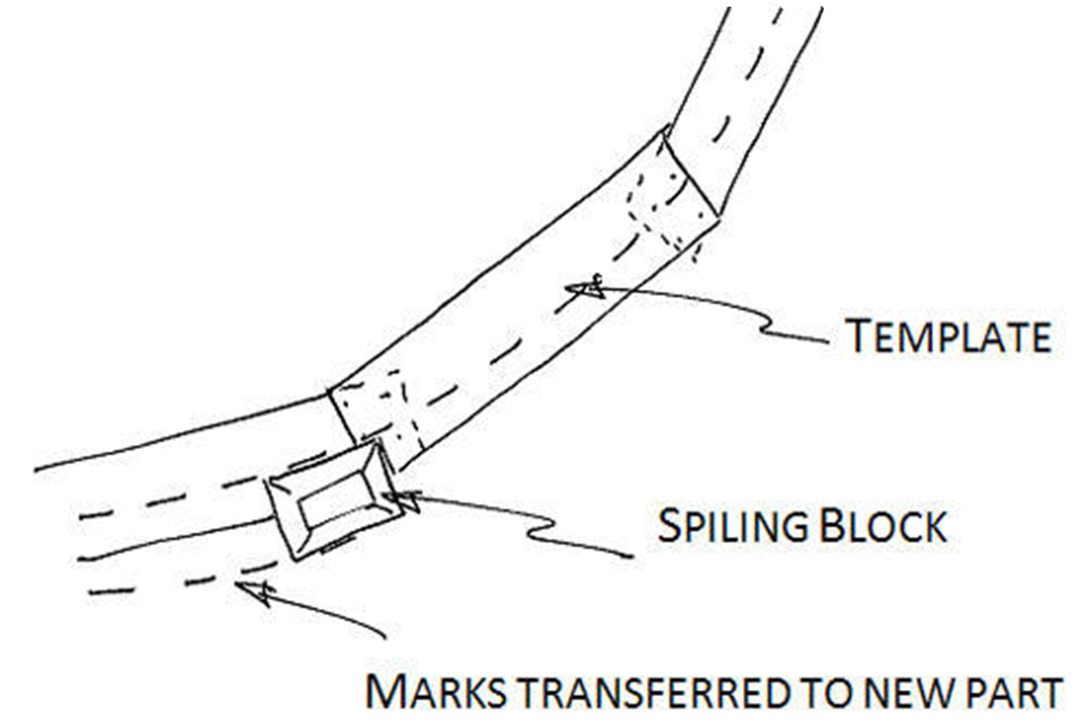
Bunk Fronts
These were glued onto the backs of the main bench frame frames, wedged from below with wooden pegs, in keeping with the way she has been finished throughout the entire boat, and finally screwed into place. The top was planed off for a smooth finish, ready for the bench tops to be added.
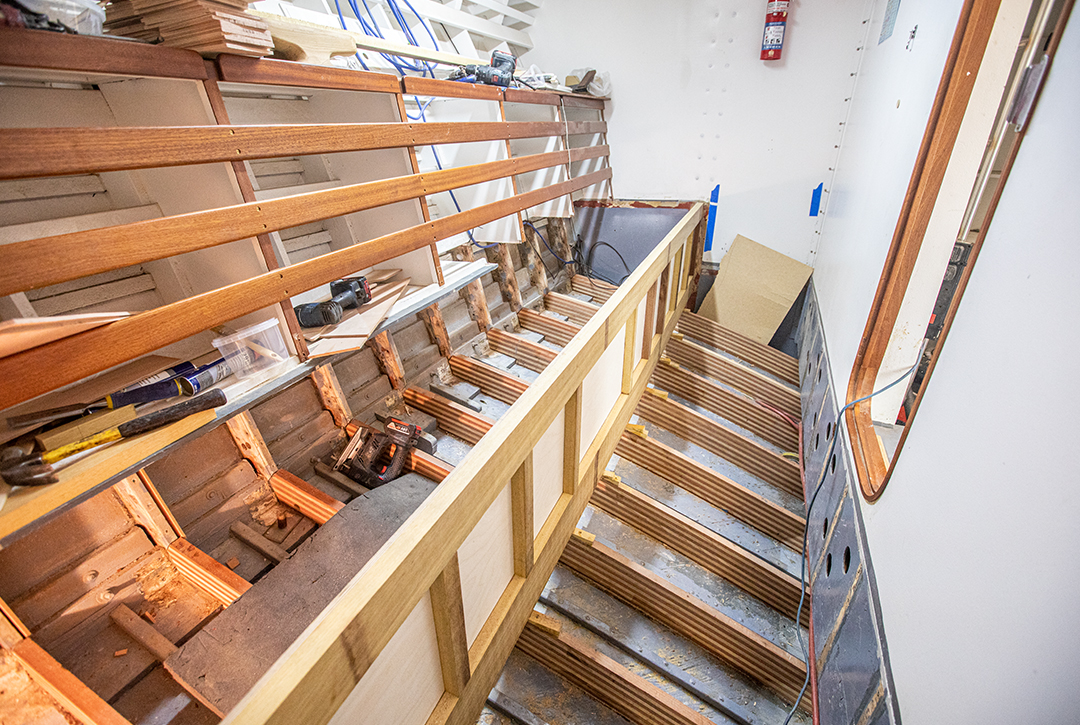
Uprights, Crossbeams & Webs to Create Structure, Shape & Flooring
The use of the plywood webs or stiffeners is to lock everything together; every corner or connection between two frames is reinforced with a web which has been glued and screwed into each frame. This pulls one to another and prevents any slipping along with stiffening up the entire structure and preventing anything from breaking or moving when she is up to speed and slamming in any swell.
When removing the original interior, a selection of each different web was carefully removed and saved in order to keep the pattern. These were replicated 300 times to create a new set, ready to be installed.
As with the frames, the webs were dry fitted and planed on site to create a perfect fit, as no 2 sets were the same – again due to the change in the hull’s angles.
The floor assembly was replaced in the same style with the structure and webs tying it all together. Rather than cutting the uprights for the main floor supports to sit flush with the angle on the hull beam below traditional methods were used. The wedges were glued into place and screwed down into the beam, the upright is then glued down and screwed through the bunk front into the structure behind. This creates a stronger support, rather than it sitting at a harsh 45° angle, it will all be square at 90°.
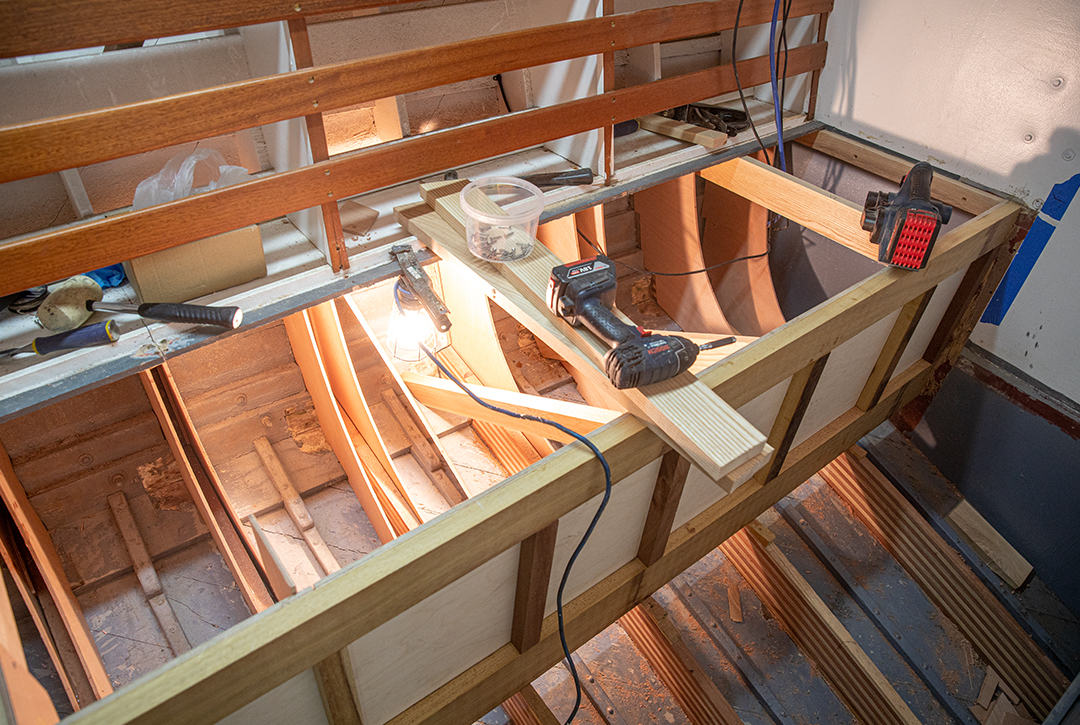
The entire forward Cabin was stripped out in the same way, apart from this time only 3 frames and the attached structure were removed at a time. This meant there was still space to move around and work without permanently working on an incline. It also prevents the hull shape from possible distortion.
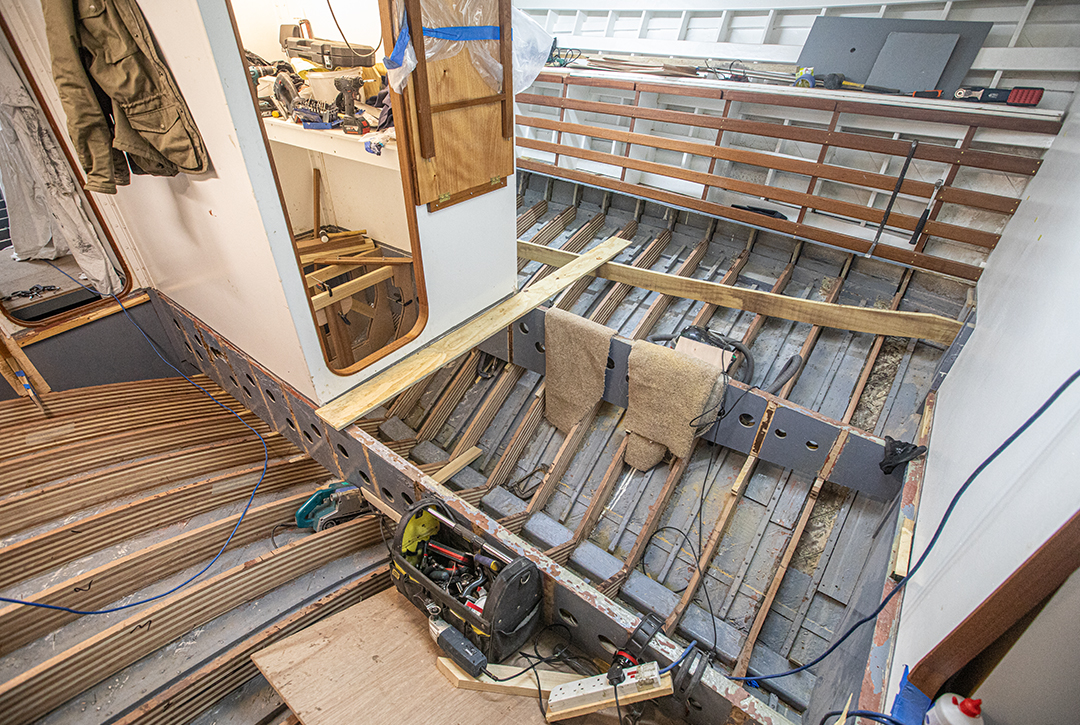
Deck Repairs
The deck sheathing was sanded back and laminated, ready to be repainted at the same time as the vessel’s topsides, deck, hull and coach roof.
Engine room fire suppression flaps
Built inside the engine rooms ventilation covers are now simple yet effective fire flaps. With a quick pull of a pin, the handle will be released and the flap will close, cutting off all oxygen to the engine room.
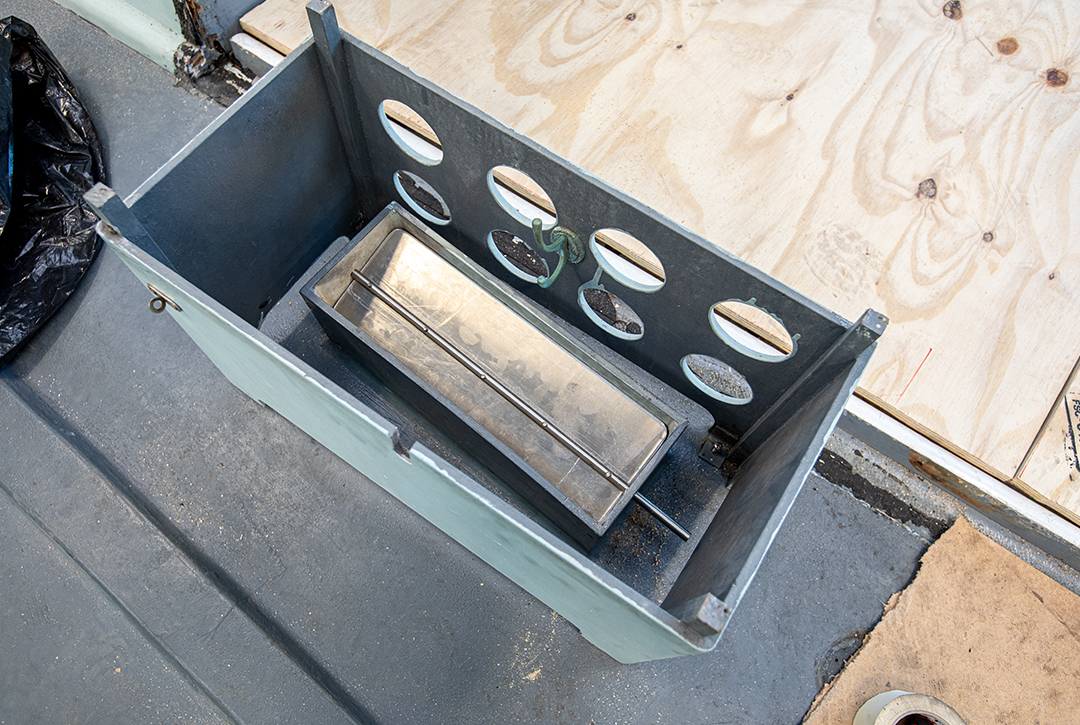
New midship & forward frames
Each new forward frame is made up of 12 planks, made from a flexible, light ash and a heavier stronger utile (hardwood), these are glued together to make a strong and flexible frame. Every pair of frames is a different shape, as the curve of the MGB hull becomes more pronounced as it gets closer to the front. This meant that every time a new set of frames is laminated the jig has to be adjusted, even if it is only by a few millimetres.
With the centreline sole bearers and diagonals removed we could start making new templates of the forward webs, and begin fitting the forward frames. (In total 300 webs and 48 frames had to be cut, shaped and fitted into place)
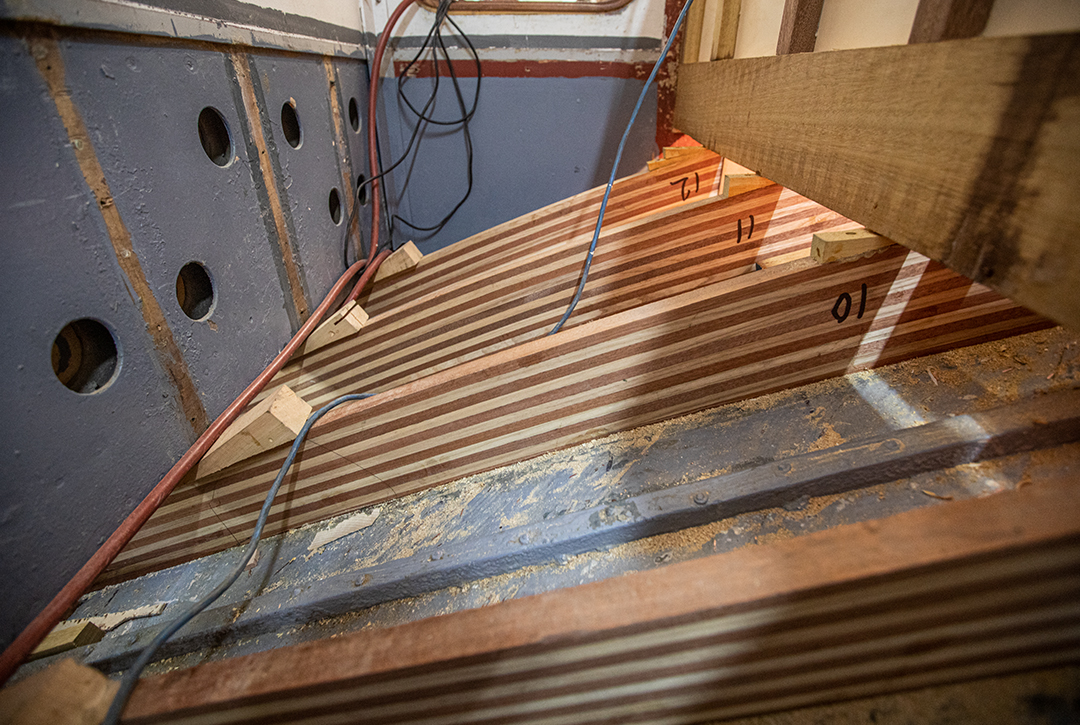
Forward box stringers/longitudinals
The existing longitudinals originally butted up against bulkheads and were glued and screwed through and fitted in place. We have now cut through the bulkhead and fitted each stringer together in the middle, with a scarf join, to make 4 longer 23’ foot stringers rather than 8 x 11’6” foot box stringers. The ends are set into the bulkheads and fitted in place. All of these changes will make her more structurally sound and far more rigid, hopefully negating the need for another refit soon. Quite clearly once a frame or two started to delaminate owing to excessive stress, others nearby then took the toll and the more movement there was the more frames became dislodged allowing moisture to wend its way into rot.
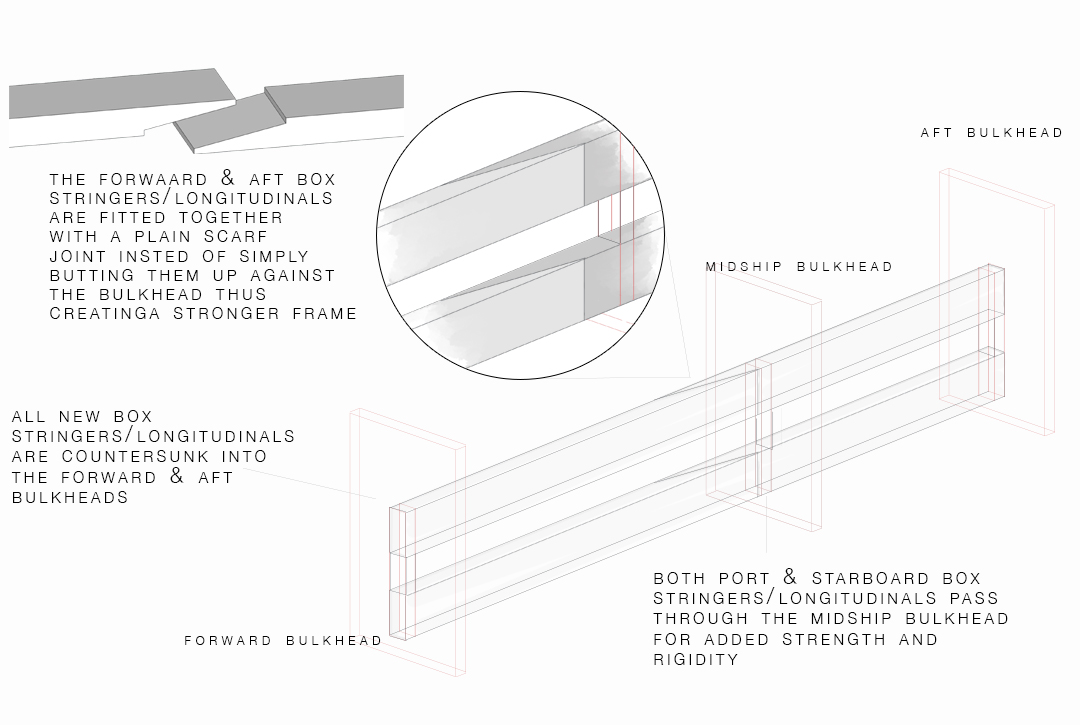
Uprights, crossbeams & webs to create structure, shape & flooring
Vertical uprights/groundwork were fitted to forward cabin longitudinal bunk fronts, in order to prevent the top longitudinal from sagging over time.
In order to attach the new structure to the original hull topside frames, plywood biscuits were fitted. These will work in the same way as all biscuits/webs and pull everything together.
A new structure of box section is fitted prior to attaching the inner plywood panel. These smaller structures will hold the original wooden fronts to the bunks.
Finally, all of the new frames, diagonals, Longitudinals and deck beams were in place ready to be painted in the original blue/grey. One section, under a removable sole board, is unpainted and varnished. This way when it is back on show any visitors will be able to see how much work goes into laminating one of the frames.
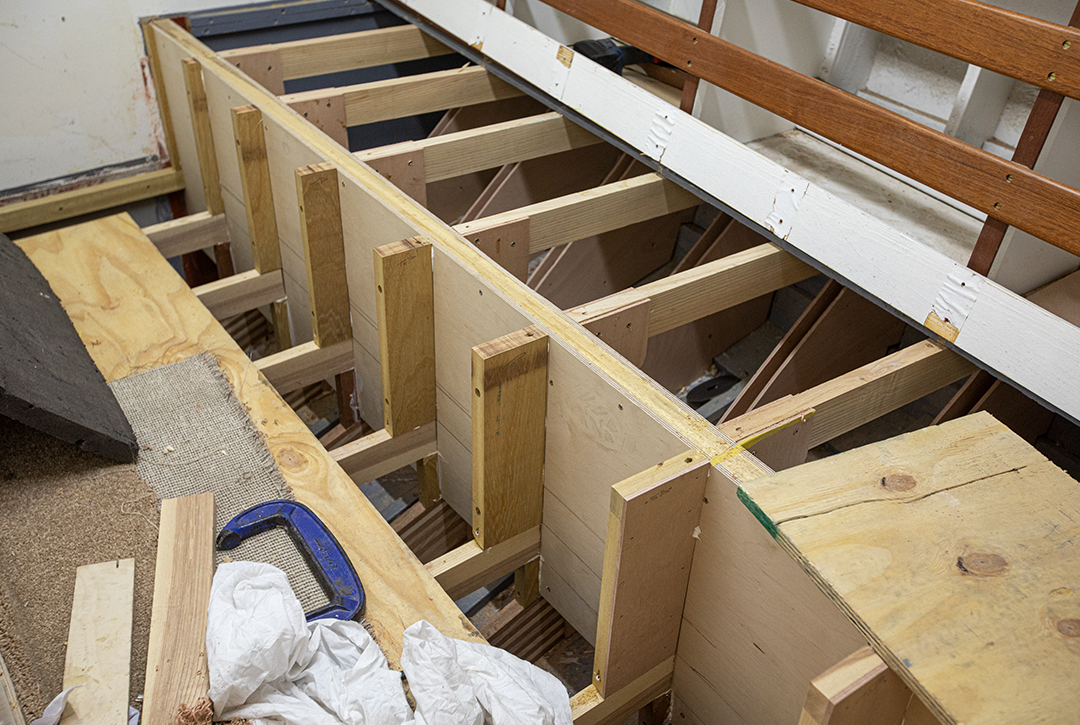
Portside hardwood rub rail
Rub rails cover a boat’s hull-to-deck joint. They are cosmetic in that they generally hide the seam and fasteners connecting these two parts, and though rub rails are no substitute for experienced handling or the proper use of fenders, they do provide protection against abrasion and mild bumps from pilings and bulkheads. Therefore, they wear and eventually need to replacing, especially if the boat lives in a commercial environment.
They were formed in the same way that the hull frames were fashioned, only this time it was a minimal bend in the wood and only 3 layers of iroco. After the glue had set, the rough shape was formed and it was fitted in place, scarph joints were used at either end and fastened with coach screws into the beam shelf internally. It was then planed and sanded down to match the original curve. Within a couple of months of her being outside and back on the water, the new rub rail will discolour to the grey appearance of the older sections at either end of the repair.
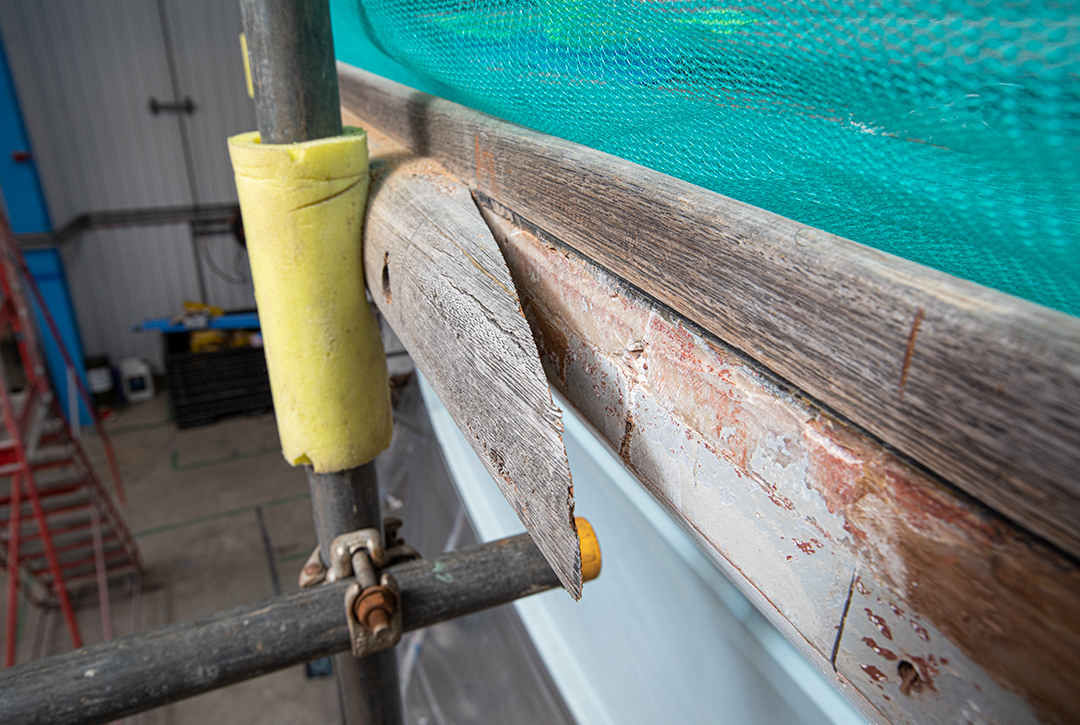
To add strength, countersunk pilot holes were drilled every 8 inches or so and obviously following the line of each frame; subsequently a 3.5 inch silicon bronze screw was secured into each.
The screwdriver machine used to fit the 3.5-inch silicon bronze screws is somewhat special. It was owned by the grandfather of Steve Phillips, a senior Berthon shipwright who worked for British Powerboats in 1940, giving it an incredibly strong chance that this screwdriver machine was used in the original build of MGB 81 back in 1942.
The main reason for resorting back to this equipment is because of how powerful it is.
The drill has to have enough power and torque to drive a screw 3.5 inches long through the 1-inch thick mahogany hull three diag under water and double diag above the waterline, followed by 2.5 inches of the ash and utile beams. For any equipment, this would be tough to drive each screw through. Even though there may be modern tools powerful enough for the job, using the traditional tools and teaching the apprentices with these methods is always preferred.
Obviously drilling a few hundred holes in the bottom of a vessel isn’t the best look or great for keeping her watertight; as a result, we sanded back the immediate surface areas, applying three layers of 300g cloth with epoxy resin over each screw head followed by a final layer of (green) peel ply which brings the by-product of epoxy curing – amien – to the surface. As per its name, the green peel ply is detached leaving clean surface for application of filler and/or paint.
After green peel ply has been removed the patches are again sanded smooth ready to accept an epoxy primer and lightly sanded back and primed for the second time before an initial patch of antifoul is added prior to a new coat of antifoul across the whole underwater section just prior to launching.
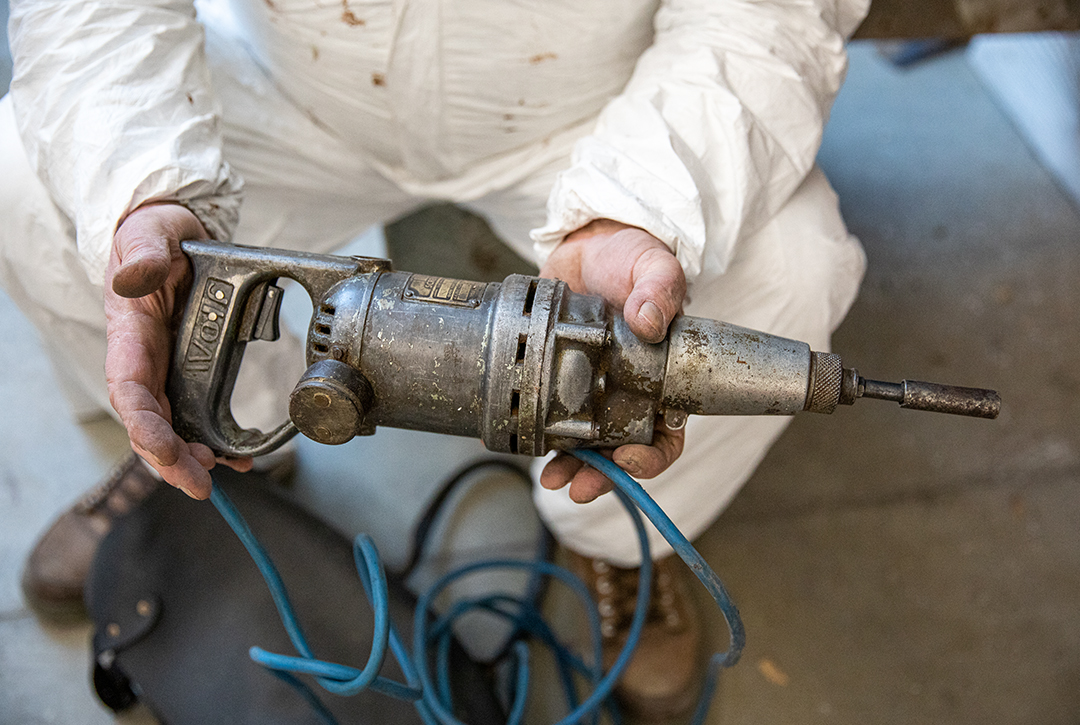
Transom Repairs
Her aft port corner was damaged which has now been filled and sanded back ready for a coat of primer before we repaint her hull and topsides.
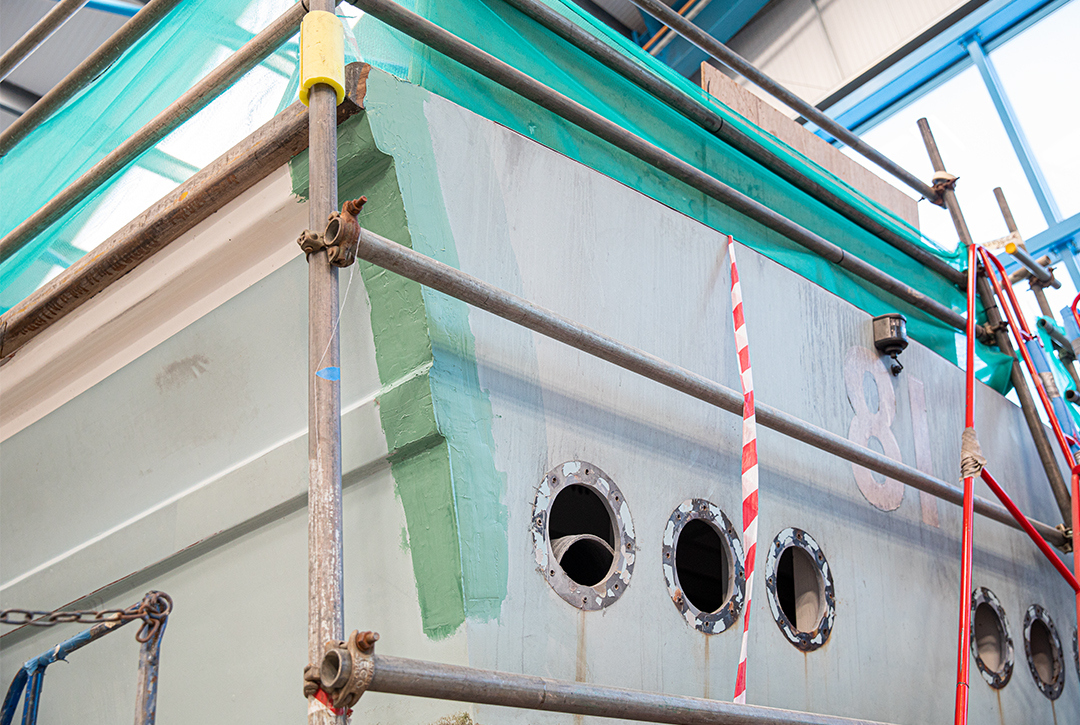
New Engines
Fitting new gearboxes takes place in order to work out the positioning of the new engines prior to the fabrication beds. The engines were mid engine fitted first followed by port then starboard.
Watch the new engines being fitted here
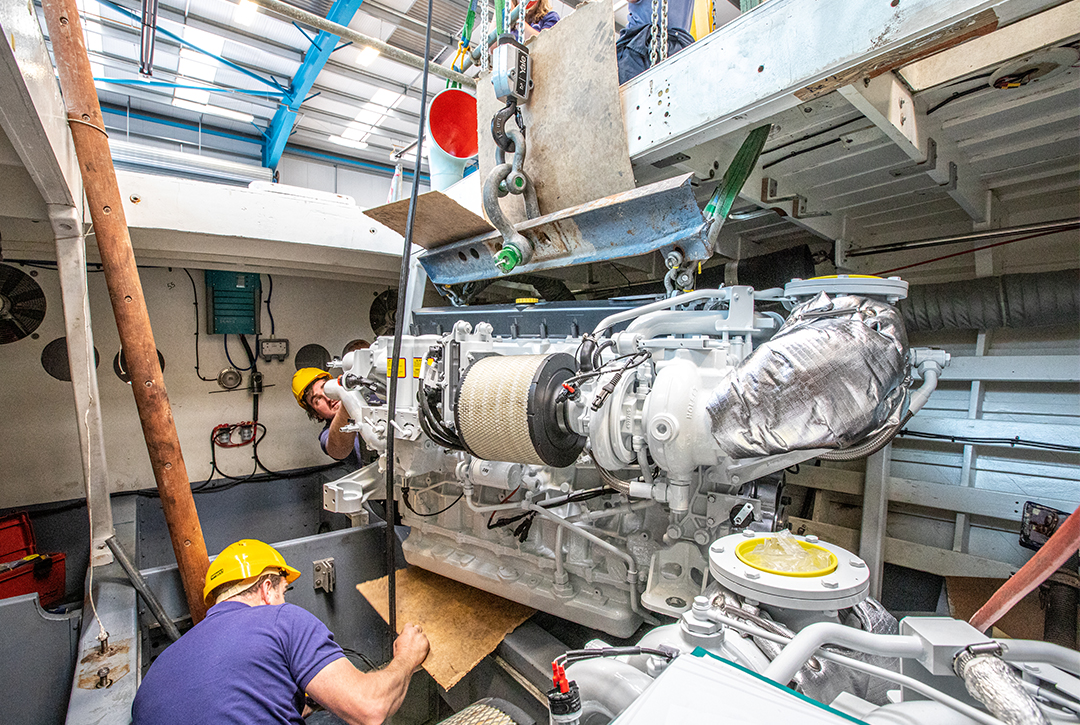
Deckhouse repairs
As ever with rot it is best to deal with it as soon as it appears because moisture will travel creating far greater expenditure in the future. Since this vessel is to be a working museum piece and therefore on the water, it is vital that all rot discovered is eliminated at this stage.
Having cut out the rot, we then glue a section plywood to fit which is laminated over with an epoxy resin. A green peel ply is then laid over, to be removed when dry giving it a cleaner and smoother finish, filled and faired with epoxy, sanded back and primed ready for a new coat of paint along with the rest of her superstructure.
Peel ply is a tough and finely woven nylon fabric treated with a release agent and used to separate the absorber breather and vacuum bag from the epoxied laminate during the vacuum bagging processes but it’s also used in hand lay-up uses to allow more pressure when squeegeeing and to protect the lay-up from contamination.
The fabric sheet is draped over the epoxied surface allowing excess epoxy to bleed through; Once it has dried, the fabric is peeled off the laminate, and what’s left behind is a perfectly smooth surface that’s ready for a quick sanding, or for the next round of epoxy, with no runs, no sagging and especially no low spots.
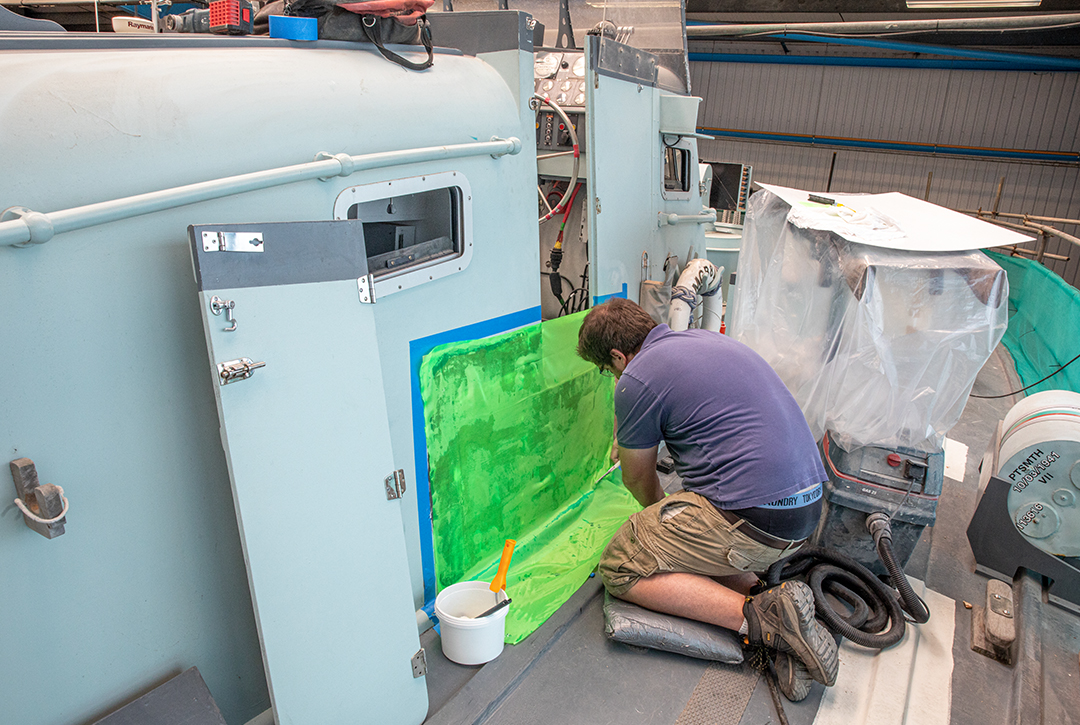
Superstructure Repaint
With the repairs to the deckhouse and superstructure complete we were able to begin sanding her topsides and superstructure with all windows, instruments lights and the horn masked off, waiting for correct temperature to apply the Jotun Conseal, a one component, physically drying acrylic coating with a matt finish. We used the original light admiralty grey for the topsides and superstructure and dark admiralty grey for the decks and top of the superstructure.
It is a high build product, meaning just one or two coatings are needed, high-build coatings also generally have a high resistance to water vapour permeability, better ‘crack-bridging’ capabilities, which guarantees a sufficient coverage of voids and other small surface imperfections which could serve as an entryway for water. It is also durable, attractive and smooth while also being resistant to wear. It is also fast drying which allows for over-coating in a short period of time and can be used directly onto metal, which is especially useful for the gun turrets.
Finally, from a cosmetic perspective this product was selected because it provides an authentic hand applied non-gloss finish to keep the original 1942 feel and look.
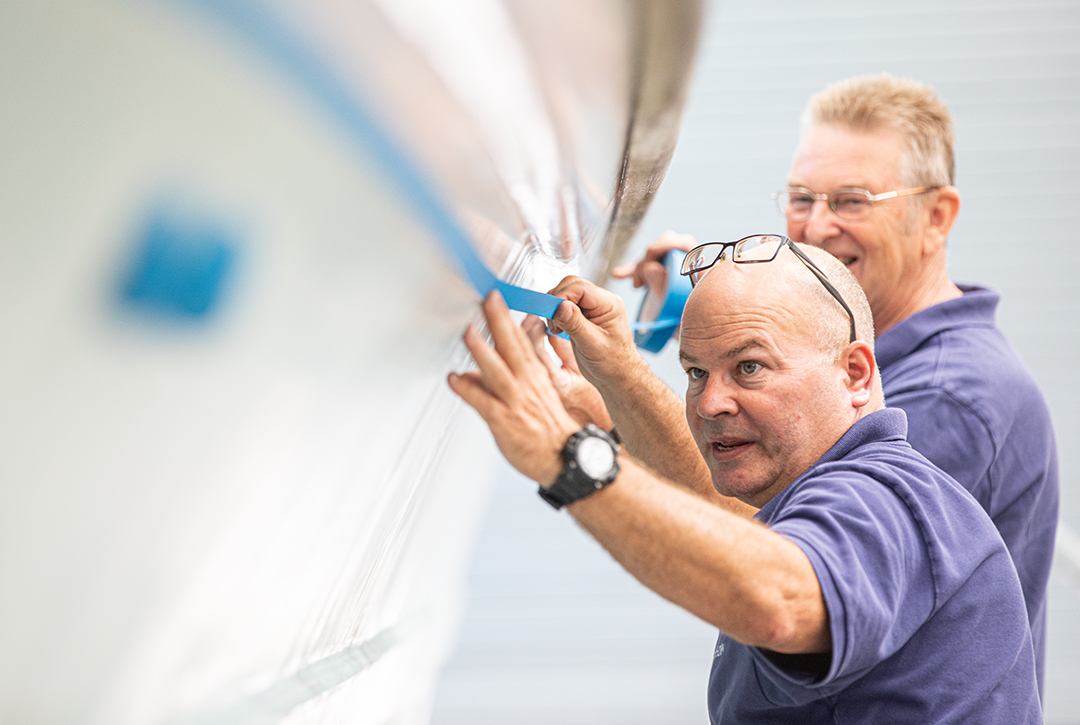
After completion of a comprehensive works list it was time for a sea trial to test the new engines. She performed beautifully and we are delighted to have been part of the project to return her back to her former glory.
Watch the sea trials here
2019 gun refresh
She has 4 guns in total, her main armament being a two-pound semi-automatic (pom pom), mounted on the foredeck, twin 20mm Oerlikons mounted up on the aft superstructure and 2 twin 0.303” Lewis machine guns fitted to rotating pedestals on deck beside the helm, along with multiple 500lb depth charges.
During her previous refit here at Berthon, the majority of the aft 20mm Oerlikons was repainted along with the superstructure, this meant only the magazines had to be painted. The biggest of all the jobs was the two-pound ‘pom pom’. This was unbolted from her fore deck, and due to her size craned off. Once safely on the ground and in our paint preparation shed it was stripped and repainted in the traditional MGB grey with the main gun black. Her twin 0.303” Lewis machine guns were stripped down to the individual components, blasted and powder coated. It’s not every day a shipwright is asked to reassemble WW2 machine guns! On completion, they were craned back on-board and re-attached.
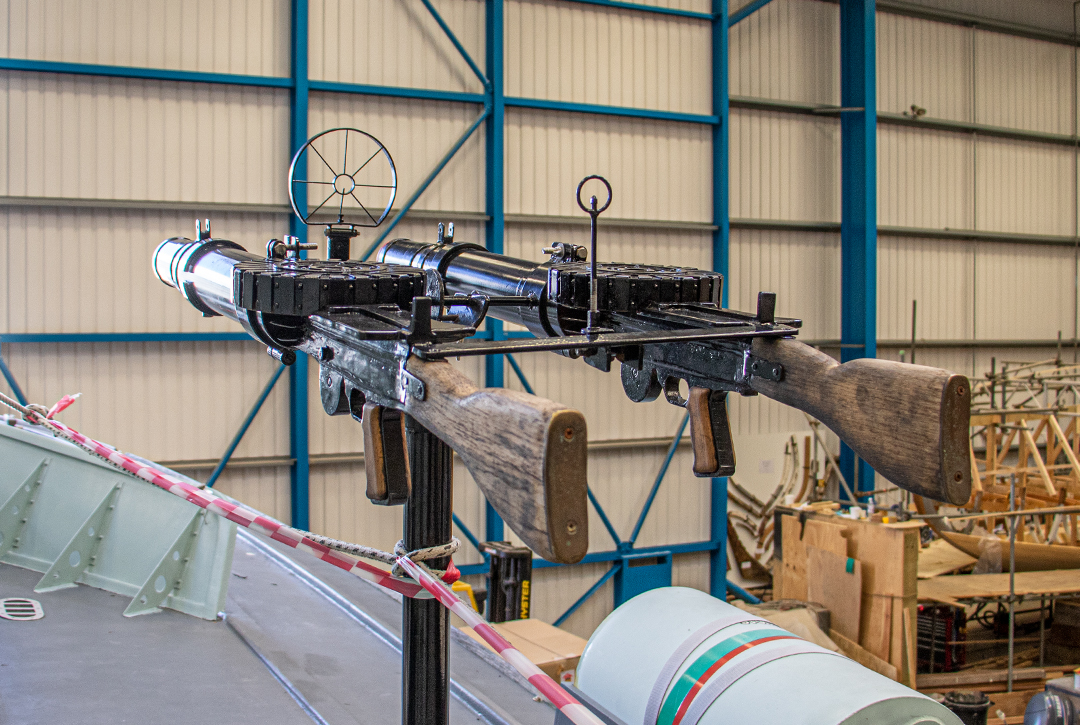
MGB 81 History
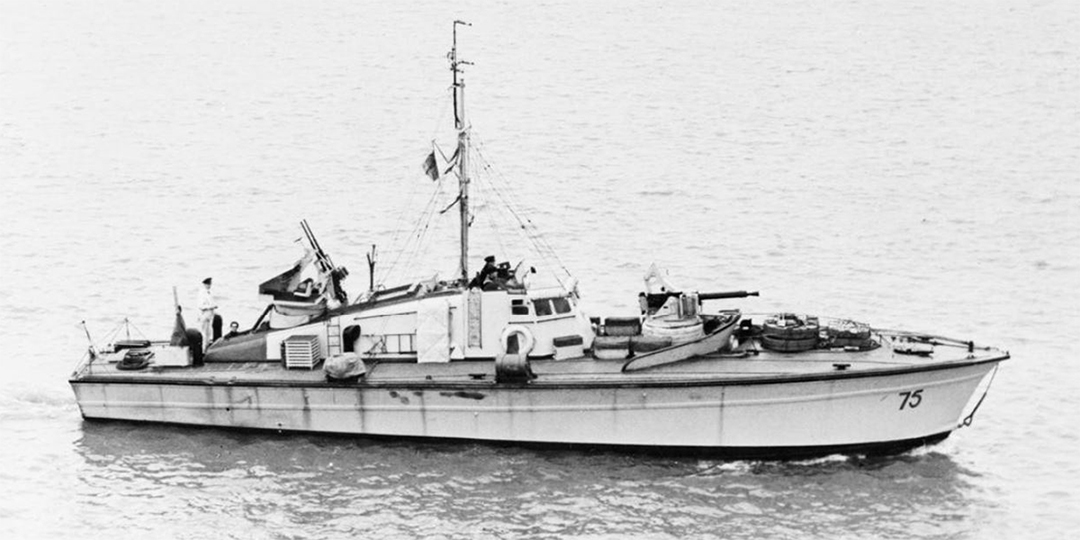
71.5ft British Power Boat MkV MGB 71ft mgb
MGB 81’s design was produced by the British Power Boat Company (BPB) in collaboration with the Admiralty and, in all, 105 of her type were built (including some which were completed as motor torpedo boats). MGB 81 had a chine hull form using double-diagonal mahogany sides and a triple diagonal mahogany bottom. Although ordered on 27 November 1940 , MGB 81 was not laid down until 16 December 1941 . She was launched on 26 June 1942 and was by then virtually complete, for she was on trials on 8 July and achieved a speed of 38.63 knots on Southampton Water.
She was accepted and commissioned on 11 July 1942 and then worked up at HMS Bee, the coastal forces base at Weymouth, before joining the 8th MGB Flotilla at Dartmouth in August 1942 . Between then and September 1943 , MGB 81 was involved in six actions.
Off Guernsey on the night of 13/14 August 1942 , she engaged in a close-range gun attack on two enemy armed trawlers and one trawler was severely damaged. The next month, the flotilla moved to Felixstowe and MGB 81 was soon in action off the Hook of Holland on 14/15 September , when two enemy motor vessels were damaged by gunfire and four armed trawlers were hit, with no damage to the MGBs.
In action off Holland on 2/3 October , four enemy armed trawlers were engaged, and one of the flotillas, MGB 78 was lost. On 27/28 February 1943 , the MGBs fought the escorts of a German convoy off the Hook, resulting in the sinking of MGB 79, and damage to MGB 81 caused by a shell hitting the engine room.
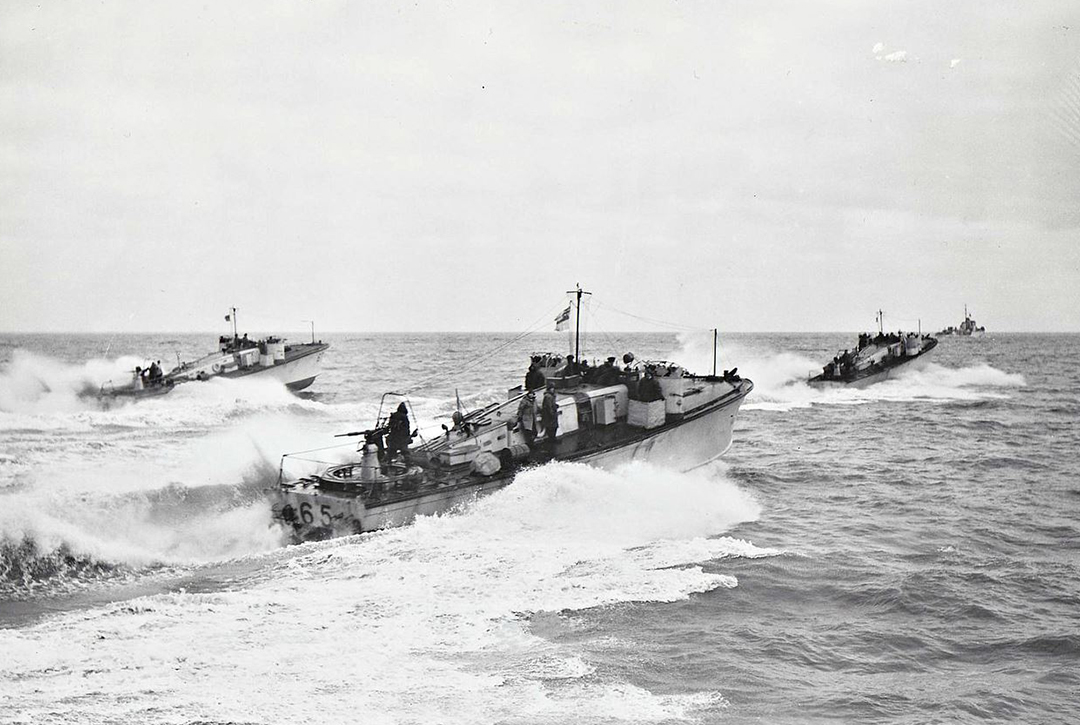
6th MGB Flotilla, 1942
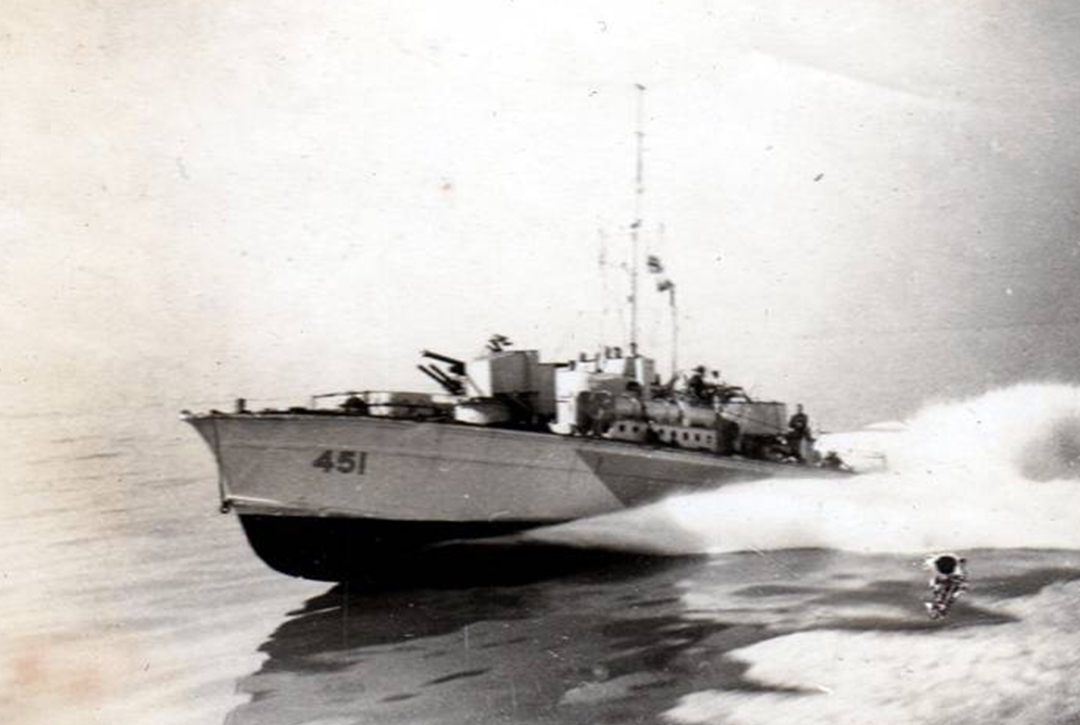
MTB 451 at speed
In April 1943 , the flotilla returned to Dartmouth, though MG 81 was refitting at Brightlingsea from 29 April to 20 May . In June 1943 , she was damaged in a collision with MGB 115 and was repaired by BPB at Poole. On 11-12 September , she again sustained damage when fired on by shore batteries at Cap la Hague and spent the rest of the month being repaired at BPB’s Poole yard.
In late September 1943 , the boat was renumbered MTB 416 and her designated armament was increased to reflect her new role, with the addition of two 18-inch torpedo tubes. Even though they were given the motor torpedo boat (MTB) classification, some of the former MGBs did not ship torpedo tubes, so it is not certain that MTB 416 was so fitted. Her flotilla became the 1st MTB Flotilla and redeployed to Ramsgate for a short period in October 1943 before returning to Dartmouth.
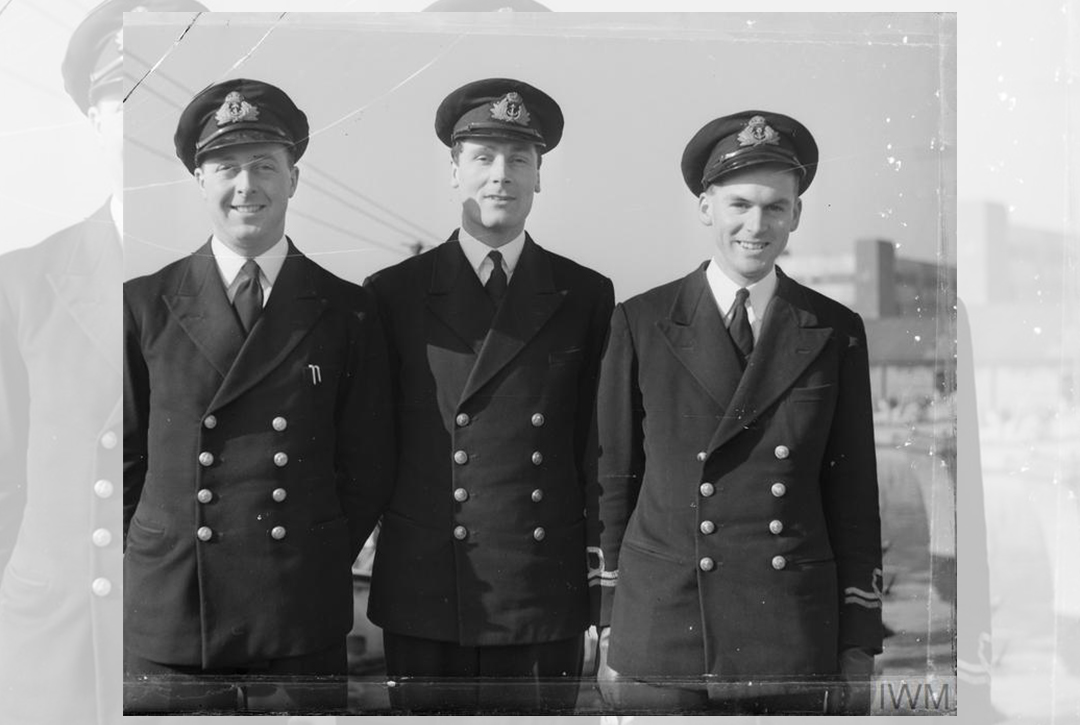
Commanding Officers of Motor Gunboats. Left to right Lieut C A Burk (MGB 17), RCNVR, from Toronto, Lieut J S Price (MGB 20), RNVR, from Blackpool, Lieut C V Dale (MGB 21), RNVR, from Sydney
MTB 416 was refitted at Poole by BPB between 5 January and 2 March 1944 . Her first recorded action as an MTB was in Lyme Bay on 21-22 April , when she engaged German E-boats and sustained action damage. Repairs were again made at Poole, but she was back in action for Normandy landings, where she was involved from 6 to 30 June 1944 , with Gosport as her base.
On the night of 23/24 June , she was involved in an attack on a German convoy leaving Cherbourg. Although MTB 416 was only backing up this operation, one of her crew was killed.
On the night of 18/19 July , she obtained hits on German R-boats off Cap d’Antifer, but her hull was damaged by gunfire and she returned to Poole again for repairs.
In September 1944 , the flotilla’s base changed to Lowestoft and her next action was on 14 February 1945 at Ostend.
On 27 April 1945 , with the war in Europe in its final days, she paid off at Poole and was placed in reserve.
Finally, on the 2nd October 1945 , she was approved for disposal and was later sold.
Very little is known about her following history until 1958 when she was arrested by Customs officers at Shoreham whilst in a smuggling operation. She was sold on for use as a sailing school accommodation ship at Hardway, Gosport, and renamed JOLLY ROGER. In 1964 , she was sold to become the houseboat CRESTA, also at Hardway.
In 1984 , she was towed to Burlesdon on the River Hamble, and in 1988 , was bought by Guy Webster to restore her to her wartime appearance. On 17 September 1998 , she was bought by Philip Clabburn and was reconstructed at the British Military Powerboat Trust’s Marchwood site between 1999 and 2002 . Petrol engines were thought to be prohibitively expensive to run, so three 1,000-bhp V-12 MAN turbocharged diesel engines were fitted, giving an estimated top speed of 45 knots.
Since late 2009 , MGB 81 has been based at Portsmouth, following her acquisition by the Portsmouth Naval Base Property Trust.
Source: Paul Brown, Historic Ships The Survivors (Amberley, 2010), updated Mar 2011.
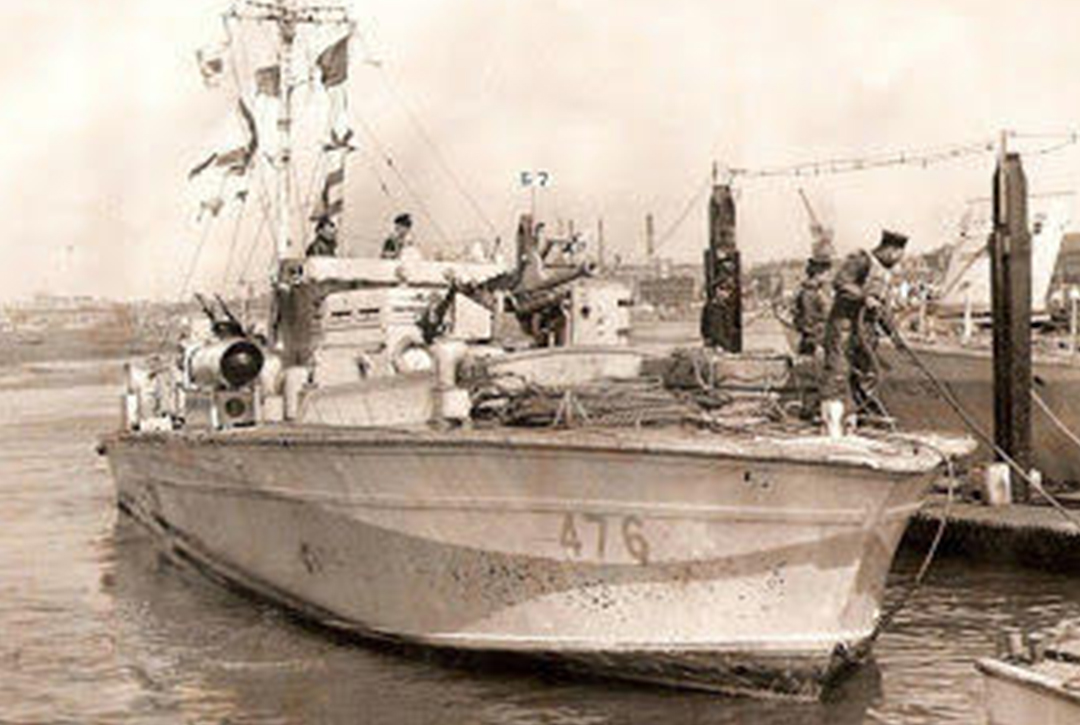
Sister ship 476 at HMS hornet 1943
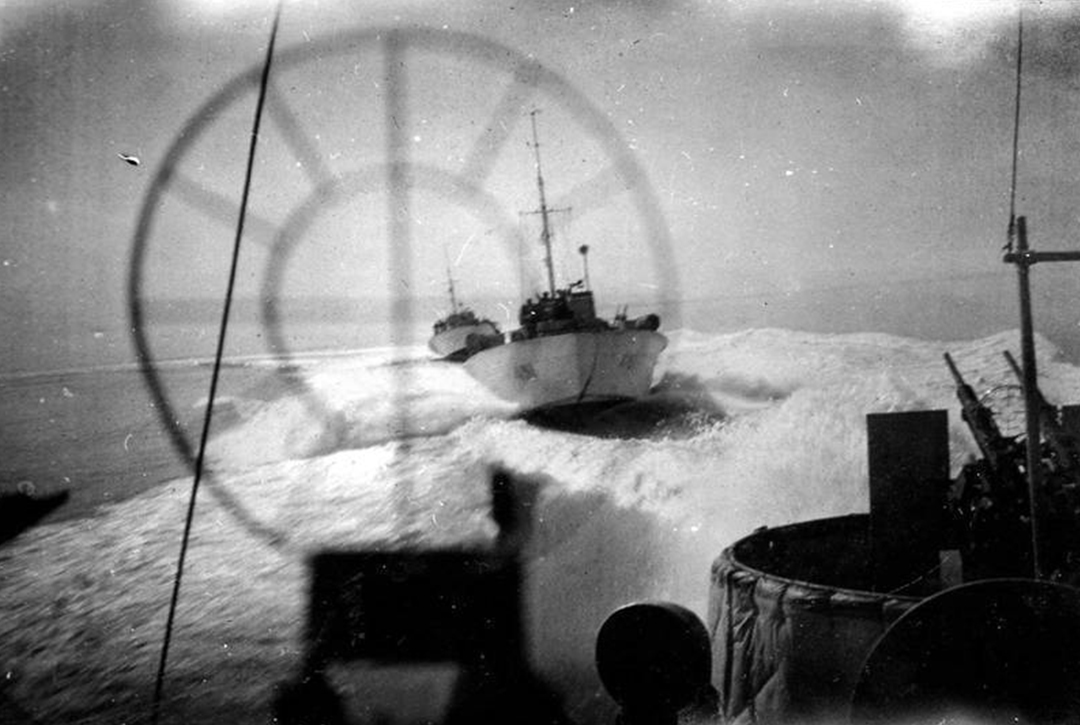
MTB 451 in the sights of 450
- 1942 – Built by the British Power Boat Co. as a Motor Gunboat
- 1942 – After extensive trials, joined the 8th MGB Flotilla at Dartmouth
- 1942 – Close range gun attack on two German armed trawlers off Guernsey
- 1943 – After escorting minelayers, contacted a German convoy north of the Hook and engaged the escorts
- 1943 – The 8th Flotilla again moved to Dartmouth and the vessel was refitted at Brightlingsea
- 1943 – Damaged in a collision with MGB 115 and repairs carried out at BPB Poole. Later damaged in an engagement off Cap de La Hague and again repaired at BPB Poole
- 1943 – Re-designated MTB 416 with two 18 inch torpedo tubes
- 1944 – Refit at BPB Poole after which she vectored onto and engaged five E-Boats in Lyme Bay, suffering damage
- 1944 – Took part in the D-Day landings and later attacked a German convoy leaving Cherbourg, during which an AB was killed
- 1944 – Attacked enemy R-Boats off Cap d’Antifer in which the CO was wounded and the vessel damaged. Further repairs at BPB Poole followed by further action
- 1945 – Approved to lay up in Category “C” Reserve at Poole, followed by final paying off
- 1945 – Bought by Mr J Evans
- 1958 – Arrested by HM Customs for smuggling and subsequently sold to a Gosport scrap dealer and used as an accommodation barge by a sailing school in Gosport under the name JOLLY ROGER
- 1964 – Bought by Mr John Ould and fitted out as a houseboat named CRESTA
- 1980 – Bought by Mr John Coker
- 1984 – Bought by Mr John Pepperell and towed to a mooring on the River Hamble at Bursledon
- 1988 – Bought by Mr Guy Webster for restoration to her wartime appearance
- 1988-1992 – Restoration work carried out
- 1990s – Moved from her mooring at Bursledon to Crableck Marina, still on the River Hamble
- 1998 – Bought by Mr Philip Clabburn for the British Military Power Boat Trust and lifted out of the water at Marchwood Military Port
- 1999-2002 – Restored to original condition and fitted with three 1000hp MAN diesel engines
- 2010 – Completed vessel bought for exhibition and display, based at the Portsmouth Historic Dockyard
- 2017-2018 – Refitted by Berthon Boat Company
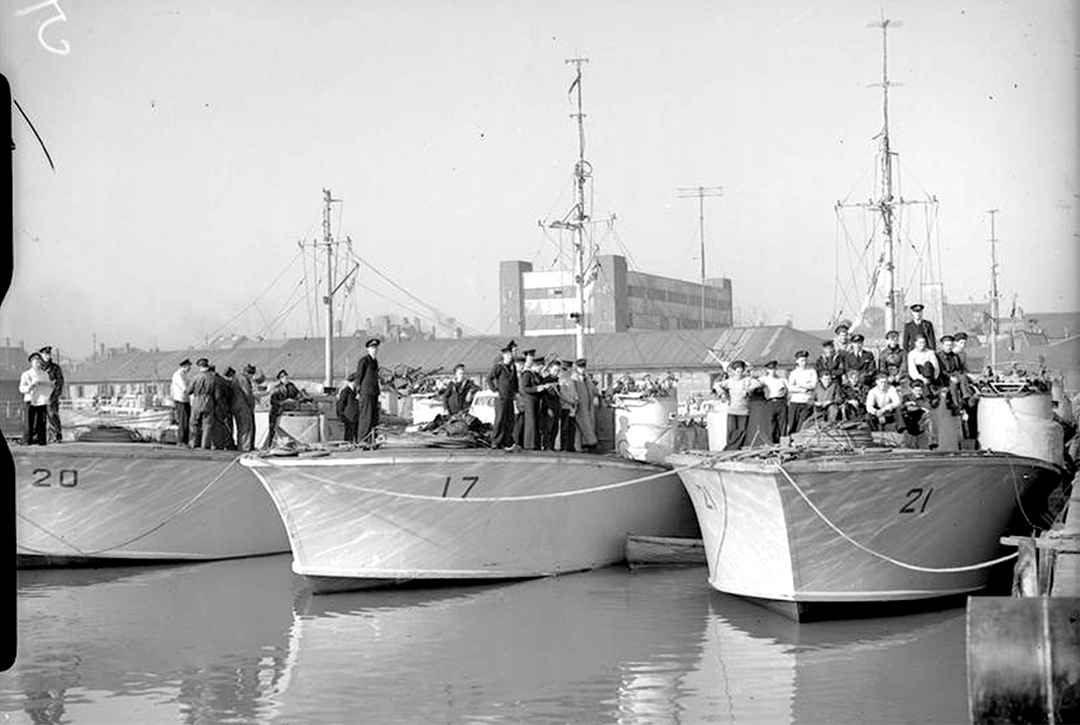
Motor gunboats MGB 17, MGB 20 and MGB 21, docked after their victory in the early hours of 8 March 1943
Search Berthon.co.uk

powered by Advanced iFrame. Get the Pro version on CodeCanyon .
Privacy Overview
| Cookie | Duration | Description |
|---|---|---|
| cookielawinfo-checkbox-advertisement | 1 year | The cookie is set by GDPR cookie consent to record the user consent for the cookies in the category "Advertisement". |
| cookielawinfo-checkbox-analytics | 11 months | This cookie is set by GDPR Cookie Consent plugin. The cookie is used to store the user consent for the cookies in the category "Analytics". |
| cookielawinfo-checkbox-functional | 11 months | The cookie is set by GDPR cookie consent to record the user consent for the cookies in the category "Functional". |
| cookielawinfo-checkbox-necessary | 11 months | This cookie is set by GDPR Cookie Consent plugin. The cookies is used to store the user consent for the cookies in the category "Necessary". |
| cookielawinfo-checkbox-others | 11 months | This cookie is set by GDPR Cookie Consent plugin. The cookie is used to store the user consent for the cookies in the category "Other. |
| cookielawinfo-checkbox-performance | 11 months | This cookie is set by GDPR Cookie Consent plugin. The cookie is used to store the user consent for the cookies in the category "Performance". |
| ct_pointer_data | session | CleanTalk–Used to prevent spam on our comments and forms and acts as a complete anti-spam solution and firewall for this site. |
| ct_timezone | session | CleanTalk–Used to prevent spam on our comments and forms and acts as a complete anti-spam solution and firewall for this site. |
| gp_easy_passthrough_session | 30 minutes | Enables the functionality of the Berth Application form which passes partial form data from one page to another in order to retain all the entered information as the user proceed through the quote process. |
| PHPSESSID | session | This cookie is native to PHP applications. The cookie is used to store and identify a users' unique session ID for the purpose of managing user session on the website. The cookie is a session cookies and is deleted when all the browser windows are closed. |
| viewed_cookie_policy | 11 months | The cookie is set by the GDPR Cookie Consent plugin and is used to store whether or not user has consented to the use of cookies. It does not store any personal data. |
| Cookie | Duration | Description |
|---|---|---|
| apbct_cookies_test | session | CleanTalk–Used to prevent spam on our comments and forms and acts as a complete anti-spam solution and firewall for this site. |
| apbct_page_hits | session | CleanTalk–Used to prevent spam on our comments and forms and acts as a complete anti-spam solution and firewall for this site. |
| apbct_prev_referer | session | CleanTalk–Used to prevent spam on our comments and forms and acts as a complete anti-spam solution and firewall for this site. |
| apbct_site_landing_ts | session | CleanTalk–Used to prevent spam on our comments and forms and acts as a complete anti-spam solution and firewall for this site. |
| apbct_site_referer | 3 days | CleanTalk–Used to prevent spam on our comments and forms and acts as a complete anti-spam solution and firewall for this site. |
| apbct_timestamp | session | CleanTalk–Used to prevent spam on our comments and forms and acts as a complete anti-spam solution and firewall for this site. |
| apbct_urls | 3 days | CleanTalk–Used to prevent spam on our comments and forms and acts as a complete anti-spam solution and firewall for this site. |
| apbct_visible_fields | session | CleanTalk–Used to prevent spam on our comments and forms and acts as a complete anti-spam solution and firewall for this site. |
| CONSENT | 16 years 6 months 15 hours | Cookie Consent. |
| ct_checked_emails | session | CleanTalk–Used to prevent spam on our comments and forms and acts as a complete anti-spam solution and firewall for this site. |
| ct_checkjs | session | CleanTalk–Used to prevent spam on our comments and forms and acts as a complete anti-spam solution and firewall for this site. |
| ct_fkp_timestamp | session | CleanTalk–Used to prevent spam on our comments and forms and acts as a complete anti-spam solution and firewall for this site. |
| ct_has_scrolled | session | CleanTalk–Used to prevent spam on our comments and forms and acts as a complete anti-spam solution and firewall for this site. |
| ct_ps_timestamp | session | CleanTalk–Used to prevent spam on our comments and forms and acts as a complete anti-spam solution and firewall for this site. |
| ct_screen_info | session | CleanTalk–Used to prevent spam on our comments and forms and acts as a complete anti-spam solution and firewall for this site. |
| ct_sfw_pass_key | 1 month | CleanTalk–Used to prevent spam on our comments and forms and acts as a complete anti-spam solution and firewall for this site. |
| ss | session | This cookie is set by the provider Eventbrite. This cookie is used for the functionality of website chat-box function. |
| __cf_bm | 30 minutes | This cookie, set by Cloudflare, is used to support Cloudflare Bot Management. |
| Cookie | Duration | Description |
|---|---|---|
| _ga | 2 years | This cookie is installed by Google Analytics. The cookie is used to calculate visitor, session, campaign data and keep track of site usage for the site's analytics report. The cookies store information anonymously and assign a randomly generated number to identify unique visitors. |
| _gat_gtag_UA_12407302_1 | 1 minute | This cookie is set by Google and is used to distinguish users. |
| _gcl_au | 3 months | Provided by Google Tag Manager to experiment advertisement efficiency of websites using their services. |
| _gid | 1 day | This cookie is installed by Google Analytics. The cookie is used to store information of how visitors use a website and helps in creating an analytics report of how the website is doing. The data collected including the number visitors, the source where they have come from, and the pages visted in an anonymous form. |
| Cookie | Duration | Description |
|---|---|---|
| ct_mouse_moved | session | Detects if the mouse has been moved |
| IDE | 1 year 24 days | Used by Google DoubleClick and stores information about how the user uses the website and any other advertisement before visiting the website. This is used to present users with ads that are relevant to them according to the user profile. |
| test_cookie | 15 minutes | This cookie is set by doubleclick.net. The purpose of the cookie is to determine if the user's browser supports cookies. |
| VISITOR_INFO1_LIVE | 5 months 27 days | This cookie is set by Youtube. Used to track the information of the embedded YouTube videos on a website. |
| YSC | session | This cookies is set by Youtube and is used to track the views of embedded videos. |
| yt-remote-connected-devices | never | Stores the user's video player preferences using embedded YouTube video. |
| yt-remote-device-id | never | Stores the user's video player preferences using embedded YouTube video. |
| yt.innertube::nextId | never | This cookie, set by YouTube, registers a unique ID to store data on what videos from YouTube the user has seen. |
| yt.innertube::requests | never | This cookie, set by YouTube, registers a unique ID to store data on what videos from YouTube the user has seen. |

Name MGB 81


Previous names
- 1942 MGB 81
- 1943 MTB 416
- 1959 Jolly Roger
- 1964 Cresta
Construction
MGB 81's design was produced by the British Power Boat Company (BPB) in collaboration with the Admiratly and, in all, 105 of her type were built (including some which were completed as motor torpedo boats). MGB 81 had a chine hull form using double-diagonal mahogany sides and a triple diagonal mahogany bottom. Although ordered on 27 November 1940, MGB 81 was not laid down until 16 December 1941. She was launched on 26 June 1942 and was by then virtually complete, for she was on trials on 8 July and achieved a speed of 38.63 knots on Southampton Water.
She was accepted and commissioned on 11 July 1942 and then worked up at HMS Bee, the coastal forces base at Weymouth, before joining the 8th MGB Flotilla at Dartmouth in August 1942. Between then and September 1943, MGB 81 was involved in six actions. Off Guernsey on the night of 13/14 August 1942, she engaged in a close-range gun attack on two enemy armed trawlers and one trawler was severely damaged. The next month, the flotilla moved to Felixstowe and MGB 81 was soon in action off the Hook of Holland on 14/15 September, when two enemy motor vessels were damaged by gunfire and four armed trawlers were hit, with no damage to the MGBs.
In another action off Holland on 2/3 October, four enemy armed trawlers were engaged, and one of the flotilla, MGB 78 was lost. On 27/28 February 1943, the MGBs fought the escorts of a German convoy off the Hook, resulting in the sinking of MGB 79, and damage to MGB 81 caused by a shell hitting the engine room. In April 1943, the flotilla returned to Darmouth, though MG 81 was refitting at Brightlingsea from 29 April to 20 May. In June 1943, she was damaged in collision with MGB 115 and was repaired by BPB at Poole. On 11-12 September, she again sustained damage when fired on by shore batteries at Cap la Hague and spent the rest of the month being repaired at BPB's Poole yard.
In late September 1943, the boat was renumbered MTB 416 and her designated armament was increased to reflect her new role, with the addition of two 18-inch torpedo tubes. Even though they were given the motor torpedo boat (MTB) classification, some of the former MGBs did not ship torpedo tubes, so it is not certain that MTB 416 was so fitted. Her flotilla became the 1st MTB Flotilla and redeployed to Ramsgate for a short period in October 1943 before returning to Dartmouth.
MTB 416 was refitted at Poole by BPB between 5 January and 2 March 1944. Her first recorded action as an MTB was in Lyme Bay on 21-22 April, when she engaged German E-boats and sustained action damage. Repairs were again made at Poole, but she was back in action for Normandy landings, where she was involved from 6 to 30 June 1944, with Gosport as her base.
On the night of 23/24 June, she was involved in an attack on a German convoy leaving Cherbourg. Although MTB 416 was only backing up this operation, one of her crew was killed. On the night of 18/19 July, she obtained hits on German R-boats off Cap d'Antifer, but her hull was damaged by gunfire and she returned to Poole again for repairs.
In September 1944, the flotilla's base changed to Lowestoft and her next action was on 14 February 1945 at Ostend. On 27 April 1945, with the war in Europe in its final days, she paid off at Poole and was placed in reserve. On 2 October 1845, MTB 416 was approved for disposal and was later sold.
Little is known about her subsequent history until 1958, when she was arrested by Customs officers at Shoreham whilst on a smuggling operation. She was sold on for use as a sailing school accommodation ship at Hardway, Gosport, and renamed JOLLY ROGER. In 1964, she was sold to become the houseboat CRESTA, also at Hardway.
In 1984, she was towed to Burlesdon on the River Hamble, and in 1988, was bought by Guy Webster to restore her to her wartime appearance. On 17 September 1998, she was bought by Philip Clabburn and was reconstructed at the British Military Powerboat Trust's Marchwood site between 1999 and 2002. Petrol engines were thought to be prohibitively expensive to run, so three 1,000-bhp V-12 MAN turbocharged diesel engines were fitted, giving an estimated top speed of 45 knots.
Since late 2009, MGB 81 has been based at Portsmouth, following her acquisition by the Portsmouth Naval Base Property Trust. Source: Paul Brown, Historic Ships The Survivors (Amberley, 2010), updated Mar 2011.
Significance
What is the vessel’s ability to demonstrate history in her physical fabric?
Although MGB 81 has undergone substantial restoration, with the decking, deckhouse and much of the internal fittings having been replaced, much of her hull is original. Only limited planking was replaced between 1988 and 2002, along with some of the longitudinal beams the lower beams of the frames in the forward half of the vessel in 2017/18. As such, the majority of her hull, the heart of the vessel, is original.
During the 1940s some 600 ‘short’ hard chine hull semi planing MTBs, MGBs and MA/SBs were constructed for Coastal Forces. At the end of 2019, only 24 of these were known to survive, all in various states of repair (including near derelict houseboats). This includes three fully restored boats (MA/SB 27, MTB 102 and MGB 81). 96 boats of the same design as MGB 81 were completed of which ten survived at the end of 2019. During their service, not one of the boats suffered from structural defects (except those caused by enemy action) and the design is considered to be one of the finest built during the war. Although the deck, deckhouse and furniture are not original, they follow the original designs and thus preserve the original appearance and layout of the boat. Only minor amendments have been made to the layout below decks.
MGB 81’s service is harder to specifically identify in her vessel fabric. A metal patch on the port side of the hull is often suggested to be part of a repair of battle damage, but this cannot be confirmed. The boat underwent substantial refits during her service where battle damage was repaired and her restorations will have similarly repaired any damage that affected the integrity of the hull. However, the hull itself is a survivor of the war and just because it no longer bears the scars of this conflict, it should not be considered to ‘show no evidence’.
What are the vessel’s associational links for which there is no physical evidence?
The British Power Boat Company built in excess of 1,000 small boats for military service during the war, in addition to many thousands of small commercial and sports boats built in the late 1920s and 1930s. The yard itself was closed in 1947 and has been totally built over by modern housing development. Now only the surviving boats, including thirteen boats that served in Coastal Forces, a number of surviving RAF and Royal Army Service Corps boats, and racing boats such as Miss England I (preserved in the Science Museum) and Miss Britain III (preserved at the National Maritime Museum) serve as a material link to a very significant boat builder. MGB 81 therefore serves as an important link to the yard and its own history.
Likewise, being one of only three Coastal Forces hard chine boats from the war that still operates (to which must also be added HDML 1387, a well preserved examples of a motor launch that also served in Coastal Forces), MGB 81 serves as an important material link to Coastal Forces. As Coastal Forces as an independent division within the Royal Navy was abolished in the 1950s, all of the bases used have long since closed and with an ever dwindling number of veterans, it is the boats that serve as the most visible and material reminder of this important arm of service during the war. MGB 81 is one of very few remaining examples (of all types) from the time.
Owing to her service in the 8th MGB Flotilla, MGB 81 has a strong link to perhaps the most famous figure in Coastal Forces, Robert Hichens. The commander of the flotilla, Hichens is the most decorated officer in the history of the RNVR and, before his death in 1943, was instrumental in establishing the tactics used by MGBs again enemy S-boats. He spent time on board MGB 81 and may even have sailed on her on occasion.
It has been possible to extract an almost complete wartime history of MGB 81 from historical sources, detailing her various deployments and engagements with the enemy (which were numerous). As such she can be presented as a true heritage vessel – complete in both form and history.
How does the vessel’s shape or form combine and contribute to her function?
Whilst British Power Boat had built a number of MTBs and MA/SBs that were later converted to MGBs in the late 1930s and 1940, MGB 81 was amongst the first batch of vessels built by the firm specifically as a Motor Gun Boat. Evidence of the specific nature of her role is visible in a number of details incorporated by Selman, including longitudinal bulkheads in the forward part of the vessel to support a 1,100kg gun and the numerous frames, stringers and webs, combined with the hog sheer of the deck to strengthen the hull in rough weather. MGB 81 therefore serves as an excellent example of a Second World War Coastal Forces boat. She embodies the lessons of early hard chine hull experimentation in the 1930s and as such her hull serves as an exceptional illustration of wartime design and construction that has benefitted from operational experience in the first year of war.
Although the berth behind Boathouse 4 was not a Coastal Forces base in the war, Portsmouth Historic Dockyard, next to an active Royal Navy base, is a very appropriate setting for a vessel of her type and MGB 81 is presented in a military environment alongside vessels of a similar size and function. Equally, although now fitted with replica weapons, MGB 81 retains the complete appearance of a motor gun boat.
Built by the British Power Boat Co. as a Motor Gunboat
After extensive trials, joined the 8 th MGB Flotilla at Dartmouth
Close range gun attack on two German armed trawlers off Guernsey
After escorting minelayers, contacted a German convoy north of the Hook and engaged the escorts
The 8 th Flotilla again moved to Dartmouth and the vessel was refitted at Brightlingsea
Damaged in a collision with MGB 115 and repairs carried out at BPB Poole. Later damaged in an engagement off Cap de La Hague and again repaired at BPB Poole
Re-designated MTB 416 with two 18 inch torpedo tubes
Refit at BPB Poole after which she vectored onto and engaged five E-Boats in Lyme Bay, suffering damage
Took part in the D-Day landings and later attacked a German convoy leaving Cherbourg, during which an AB was killed
Attacked enemy R-Boats off Cap d’Antifer in which the CO was wounded and the vessel damaged. Further repairs at BPB Poole followed by further action
Approved to lay up in Category “C” Reserve at Poole, followed by final paying off
Bought by Mr J Evans
Arrested by HM Customs for smuggling and subsequently sold to a Gosport scrap dealer and used as an accommodation barge by a sailing school in Gosport under the name JOLLY ROGER
Bought by Mr John Ould and fitted out as a houseboat named CRESTA
Bought by Mr John Coker
Bought by Mr John Pepperell and towed to a mooring on the River Hamble at Bursledon
Bought by Mr Guy Webster for restoration to her wartime appearance
Restoration work carried out
Moved from her mooring at Bursledon to Crableck Marina, still on the River Hamble
Bought by Mr Philip Clabburn for the British Military Power Boat Trust and lifted out of the water at Marchwood Military Port
Restored to original condition and fitted with three 1000hp MAN diesel engines
Completed vessel bought for exhibition and display, based at the Portsmouth Historic Dockyard
£580,000 was awarded by the National Memorial Heritage Fund to purchase HSL 102 and MGB 81
North, A J D, Royal Naval Coastal Forces, Almark Publications, 1972 World Ship Society British Armed Forces Small Craft Historical Society, Survivors Register, 1998 Classic Boat: Sea Trials for MGB81 , February 2003 Classic Boat: Gunning a gunboat, September 2011 Classic Boat: Power and the Glory, February 2004 Hudson, Geoffrey, WSS Small Craft Group Journal: Motor Gun Boat (MGB) 81, pp68-75, December Volume 14, 1999
Own this vessel?
If you are the owner of this vessel and would like to provide more details or updated information, please contact [email protected]
More like this
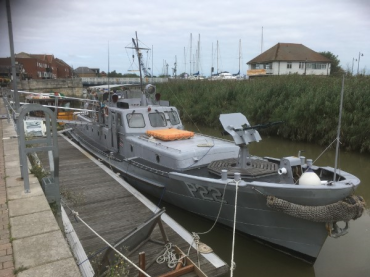
Registered, built 1952 by Hizzler Ship Yard
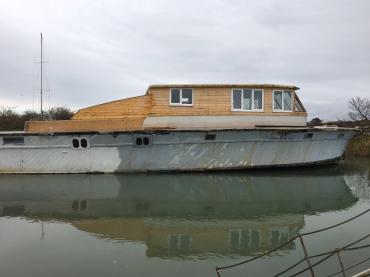
MGB 118 - Fontenay
Registered, built 1942 by british power boat co ltd. hythe.
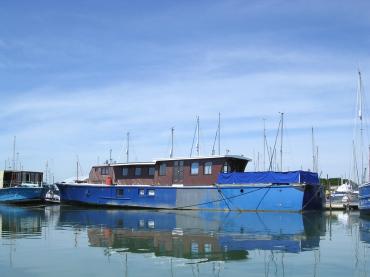
Registered, built 1943 by Curtis, Frank, Looe
National Historic Ships UK acknowledges the financial support of its sponsors
- The Registers
- Shipshape Network
Log in to online services
BRITISH MILITARY POWERBOAT TRUST
Charity overview, activities - how the charity spends its money.
Information on the charity's activities is not available.
Income and expenditure
Data for financial year ending 30 May 2005
Fundraising
Trustee payments, what, who, how, where.
- Education/training
- Environment/conservation/heritage
- Children/young People
- Elderly/old People
- Other Charities Or Voluntary Bodies
- The General Public/mankind
- Provides Human Resources
- Throughout England And Wales
- 11 December 1998: Standard registration
- 30 April 2007: Removed (Funds transferred (incor))
- 30 April 2007: Funds transferred to 1109369 BRITISH MILITARY POWERBOAT TRUST LIMITED
- BMPT (Working name)
Financial history
Financial period end date.
| Income / Expenditure | 31/03/2004 | 30/05/2005 | ||
|---|---|---|---|---|
| Total gross income | £52.00k | £70.11k | ||
| Total expenditure | £45.00k | £76.14k | ||
| Income from government contracts | N/A | N/A | ||
| Income from government grants | N/A | N/A |
Accounts and annual returns
| Title | Reporting year | Date received | Received | Download |
|---|---|---|---|---|
| Annual return | 30 May 2005 | 06 April 2006 | 7 days late | |
| Accounts and TAR | 30 May 2005 | 31 March 2006 | 1 days late | |
| Annual return | 31 March 2004 | 15 October 2004 | On time | |
| Accounts and TAR | 31 March 2004 | 15 October 2004 | On time |
(Charity users only)
Governing document
CONSTITUTION ADOPTED 22ND OCTOBER 1998
Charitable objects
(I) TO MAINTAIN AND PRESERVE FOR PUBLIC BENEFIT BRITISH MILITARY POWERBOATS OF HISTORICAL INTEREST. (II) TO ADVANCE THE EDUCATION OF THE PUBLIC IN THE HISTORICAL CONTEXT OF BRITISH MILITARY POWERBOATS.
Area of benefit
NOT DEFINED
Tell us whether you accept cookies
We use cookies to collect information about how you use the Charity Commission Register of Charities and Digital Services, such as pages you visit.
We use this information to better understand how you use our website so that we can improve your user experience and present more relevant content.
Thank you for your feedback. Do you have 5 minutes to tell us what you think of this service? Open in new window
Log in or Sign up
You are using an out of date browser. It may not display this or other websites correctly. You should upgrade or use an alternative browser .
Discussion in ' The War at Sea ' started by rania , Apr 13, 2005 .
rania Junior Member
I am looking for information on any surviving British Powerboat 63' Whaleback (ASR) or indeed any coastal command craft that are languishing in UK waters that still could be saved? There must still be many in small harbours and converted houseboats etc. I would like to make a list of all surviving Coastal craft and publish it on the web so people with an interest could find out more about them and hopefully interested parties could save a few. MTB's, MGB's, ML's, HDML's, Seaplane tenders etc. I'd appreciate any information on any survivors that you know of. Any information would be welcome, location, photos, owners, etc. My email is [email protected] Thank you
morse1001 Very Senior Member
I do think that there are any more whalebacks or for that matter Dorest and hants boats lying about. There are however, many MTBs which were converted to Radar targets and are moored in various harours around the coast.
adrian roberts Senior Member
Don I don't know if you are aware of the ones that are already in museums, but in case you aren't I attach a couple of pages from the Museums supplement to Ships Monthly, June 2003. The entries you would be interested in are the Marchwood British Military Powerboat Trust, and the MGB60 and MTB102 One of these vessels, MGB60 I think, has since been destroyed in a mindless arson attack. In Salcombe estuary, slightly upstream from the town, is a #houseboat which looks very much like a converted naval craft, possibly a corvette, but I was unable to find out more details If the attachments don't come out legibly and you are interested, email me and I will write out the details and send them Adrian
Thanks all, I'm restoring a little Seaplane Tender hence the interest. I found a surviving (just) Whaleback in Spain last year. Photos at: http://www.rania.co.uk/asr Is anyone else out there working on old ex-mod boats? Don
Sorry, what a plonker. Link is http://www.rania.co.uk/boat%20photos/whaleback/ More original ASR photos I have are at: http://www.rania.co.uk/asr-ww2/ a booklet on all ASR boats is at: http://www.rania.co.uk/ASR-boats/ Don
Sorry, what a plonker. Link is http://www.rania.co.uk/boat%20photos/whaleback/ More original ASR photos I have are at: http://www.rania.co.uk/asr-ww2/ a booklet on all ASR boats is at: http://www.rania.co.uk/ASR-boats/ Don Thanks for that, very interesting material
Kitty Very Senior Member
Aww cute! Want one!
Share This Page
- No, create an account now.
- Yes, my password is:
- Forgot your password?
- Search titles only
Separate names with a comma.
- Search this thread only
- Display results as threads
Useful Searches
- Recent Posts
Cookies on Companies House services
We use some essential cookies to make our services work.
We'd also like to use analytics cookies so we can understand how you use our services and to make improvements.
You've accepted analytics cookies. You can change your cookie settings at any time.
You've rejected analytics cookies. You can change your cookie settings at any time.
We use cookies to make our services work and collect analytics information. To accept or reject analytics cookies, turn on JavaScript in your browser settings and reload this page.
Please press ENTER to search
BRITISH MILITARY POWERBOAT TRUST LIMITED
Company number 05081021
- Company Overview for BRITISH MILITARY POWERBOAT TRUST LIMITED (05081021)
- Filing history for BRITISH MILITARY POWERBOAT TRUST LIMITED (05081021)
- People for BRITISH MILITARY POWERBOAT TRUST LIMITED (05081021)
- More for BRITISH MILITARY POWERBOAT TRUST LIMITED (05081021)
Last accounts made up to 30 June 2009
Nature of business (SIC)
- 9252 - Museum & preservation of history
IMAGES
COMMENTS
The British military powerboats of the 1930s and 1940s were the finest in the world. Developed from a series of record breaking speedboats, these rugged, graceful craft were so far ahead of their time that their design has never been surpassed
The British Military Powerboat Trust (BMPT) was formed in 1999, and secured premises at the Husbands Shipyard sheds, Marchwood, Southampton. The object was to create a centre of excellence covering the restoration of military powerboats, and display these both on the water, as well as in a museum scenario.
British Military Powerboat Trust: Intention to get her seaworthy MGB 81: 71.5 ft (21.8 m) Motor gunboat 1942 British Power Boat Company Portsmouth Naval Base Property Trust: Fully operational, based at Portsmouth Historic Dockyard. MTB 71: 60 ft (18 m) Motor torpedo boat 1940 ...
British Military Powerboat Trust. S130 is now a part of the Wheatcroft Collection and Roving Commissions are restoring her to her original WW2 specification which includes the original engines, torpedo tubes and other armaments. The Wheatcroft Collection is one of the world's largest private held collections of
The Trust recently inherited the former British Military Powerboat Trust's collection, which includes a small Air Sea Rescue craft and a motorboat tender from Ark Royal. HLS 102 and MGB 81 will represent the Trust's most significant acquisitions to date. Further information. Natasha Ley or Alison Scott, NHMF Press Officers,
Coastal Motor Boat was a small high-speed British torpedo boat used by the Royal Navy in the First World War and up to end of the Second World War. ... MTB 331, owned by Hampshire County Council and on-loan to the British Military Powerboat Trust (BMPT) at Marchwood, is the sole surviving 55-foot CMB.
Tuesday 4th April 2023 - The British Military Powerboat Trust by Robin Cooper Robin will be focusing on the historic Marchwood facility, previously Husbands Shipyard, when British Military...
Design British Powerboat Company Built 1942 In the care of Portsmouth Naval Base Property Trust Notes HNoMS Hitra: Norway submarine chaser Only remaining World War II submarine chaser with intact armament : S-130 Germany E-boat: 1943 British Military Powerboat Trust : Only surviving German E-boot. Participated in Exercise Tiger and attacks on ...
PNBPT. Berthon was awarded the contract by Portsmouth Naval Base Property Trust for the restoration and re-engining of the famous Motor Gun Boat 81 (MGB81) funded by the Chancellor using LIBOR funds. MGB 81 is a 71.5ft Motor Gun Boat built by the British Powerboat Company for the Royal Navy and launched on 26 June 1942.
British Military Powerboat Trust A dead website / forum that contains several informative pages on smaller craft. List of yards (started 04/09/23, very early draft) - British Powerboat Company - J. Samuel Whites, Cowes. - Thornycroft - Morgan Giles - Vospers - Walton Yacht and Launch Company. Literature
On 17 September 1998, she was bought by Philip Clabburn and was reconstructed at the British Military Powerboat Trust's Marchwood site between 1999 and 2002. Petrol engines were thought to be prohibitively expensive to run, so three 1,000-bhp V-12 MAN turbocharged diesel engines were fitted, giving an estimated top speed of 45 knots. ...
The British military powerboats of the 1930s and 1940s were the finest in the world. Developed from a series of record breaking speedboats, these rugged, graceful craft were so far ahead of their time that their design has never been surpassed ... George Selman, some 54 of this type were built as Mid craft by British Power Boats between 1940 ...
BRITISH MILITARY POWERBOAT TRUST. Charity number: 1072916 Removed charity Charity overview. Activities - how the charity spends its money Information on the charity's activities is not available. Income and expenditure Data for financial year ending 30 May 2005 Total income: £70,114 ...
The British military powerboats of the 1930s and 1940s were the finest in the world. Developed from a series of record breaking speedboats, these rugged, graceful craft were so far ahead of their time that their design has never been surpassed ... In 1927 Hubert Scott-Paine bought the Hythe Shipyard and the British Power Boat Company was born ...
The British Military Powerboat Trust. Aerospace & Defense · United Kingdom · <25 Employees . The British military powerboats of the 1930s and 1940s were the finest in the world. Developed from a series of record breaking speedboats, these rugged, graceful craft were so far ahead of their time that their design has never been surpassed Read ...
The Dark class, or Admiralty "Type A", were a class of eighteen fast patrol boats that served with the United Kingdom's Royal Navy starting in 1954. All were named with a prefix of 'Dark'. The class could be fitted as either motor gun boats or motor torpedo boats, depending on the type of armament carried.They were the only diesel engined fast patrol boats in the Royal Navy.
I am looking for information on any surviving British Powerboat 63' Whaleback (ASR) or indeed any coastal command craft that are languishing in UK waters that still could be saved? ... The entries you would be interested in are the Marchwood British Military Powerboat Trust, and the MGB60 and MTB102 One of these vessels, MGB60 I think, has ...
The British military powerboats of the 1930s and 1940s were the finest in the world. ... Owned and operated by Powerboat Restorations currently residing at the Trust. PRINCIPAL PARTICULARS: Type: 71'/2ft Motor Gun Boat Mk V : Service: Royal Navy: Builders: British Power Boat Co. Year Built: 1942: Number Built: 112: Displacement: 46.6 Tons ...
More for BRITISH MILITARY POWERBOAT TRUST LIMITED (05081021) Registered office address 30a Bedford Place, Southampton, Hampshire, SO15 2DG . Company status Dissolved Dissolved on 20 July 2010. Company type Private company limited by guarantee without share capital Incorporated on 23 March 2004 ...
The Type Two HSL was a 63 ft high-speed launch craft made by British Power Boat Company (BPBC). The craft were used during the Second World War for air-sea rescue operations to save Allied aircrew from the sea. The Type Two superseded the 64 ft HSL, and was itself replaced by the Type Three 68 ft "Hants and Dorset" also built by the BPBC. The Type Two (aka Type 2) was nicknamed the "Whaleback ...
The British Military Powerboat Trust was established to create a national Exhibition Centre which will display the innovation, development and history of the high-speed craft used by the British armed forces in the 20th century, and bring them to life. The emphasis will be firmly upon the chance for all to experience the dynamism of the real ...
British Military search results on 19-06-2024 at 23:31:32. 8 Company search results
The British military powerboats of the 1930s and 1940s were the finest in the world. Developed from a series of record breaking speedboats, these rugged, graceful craft were so far ahead of their time that their design has never been surpassed ... In 1927 Hubert Scott-Paine bought the Hythe Shipyard and the British Power Boat Company was born ...